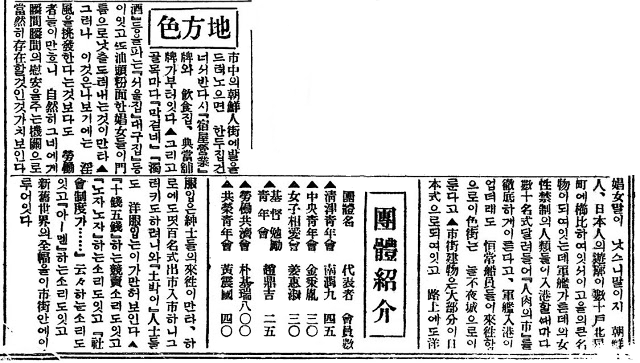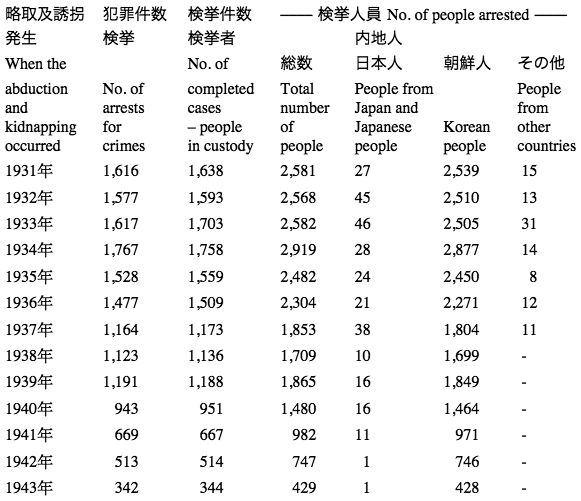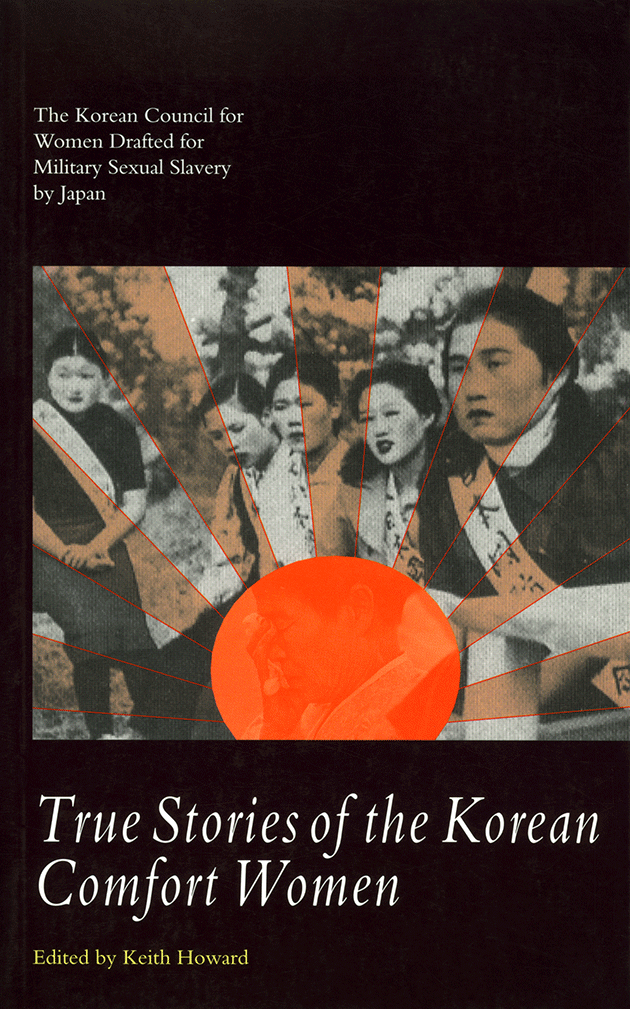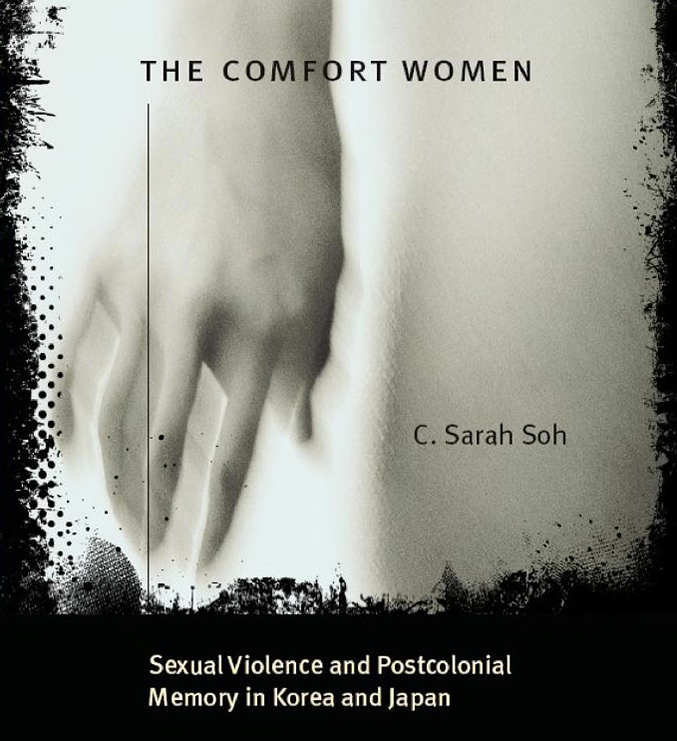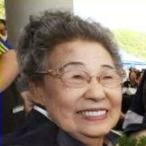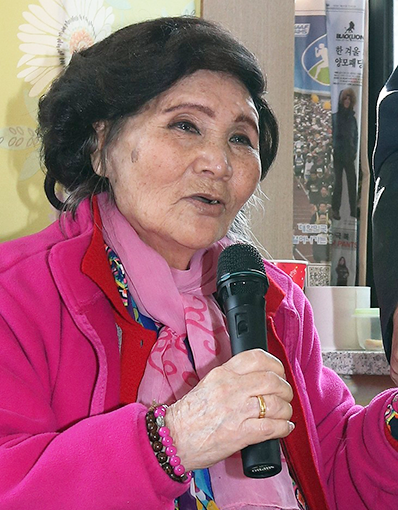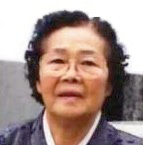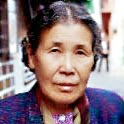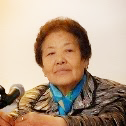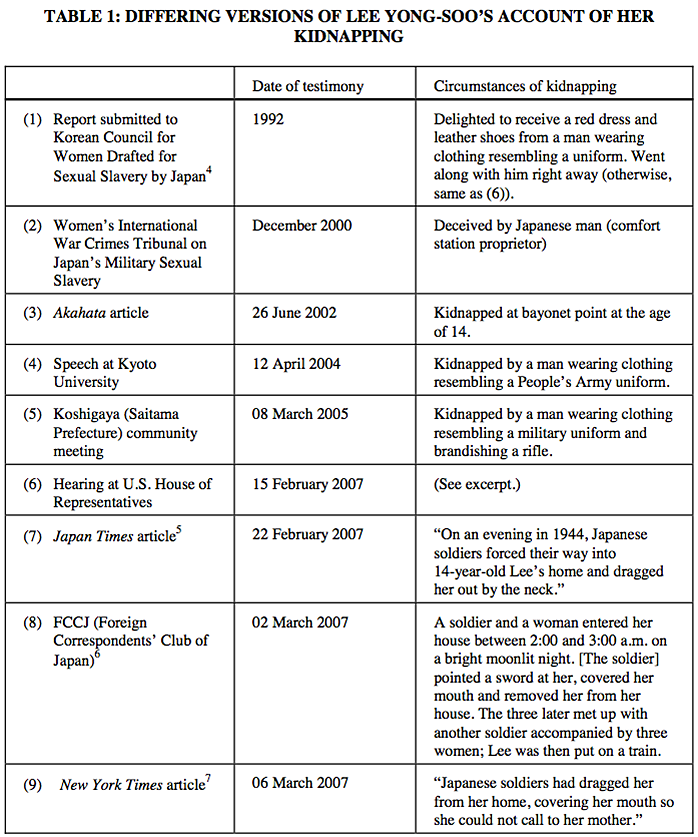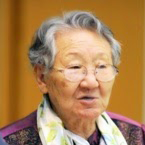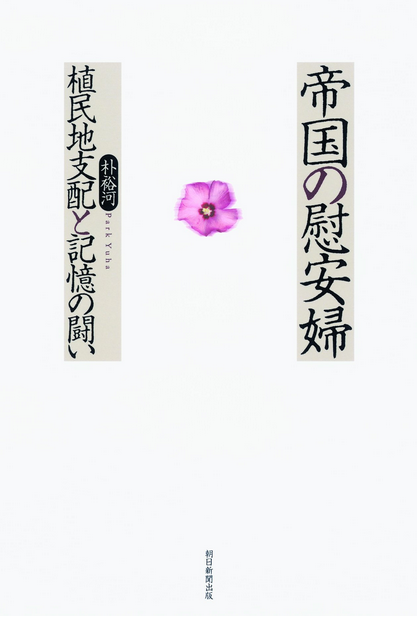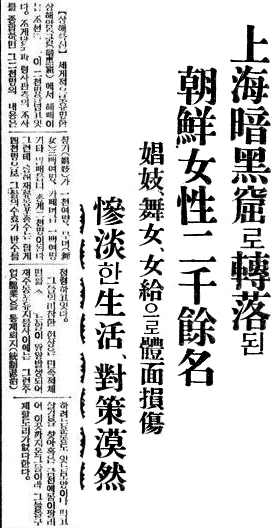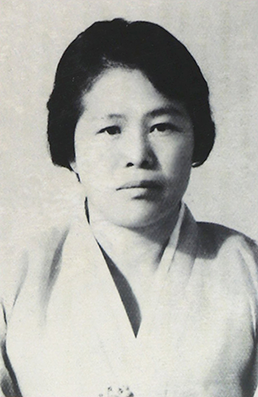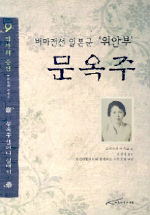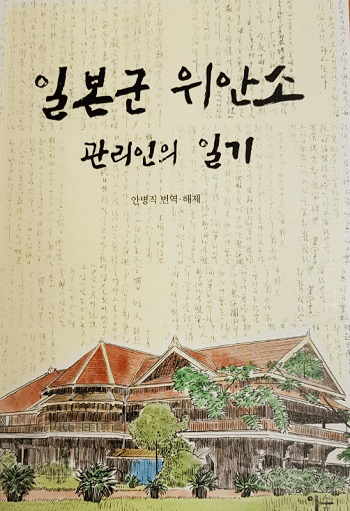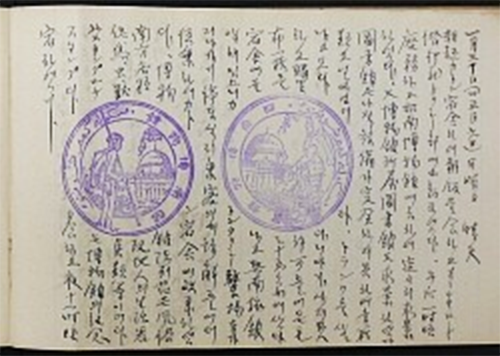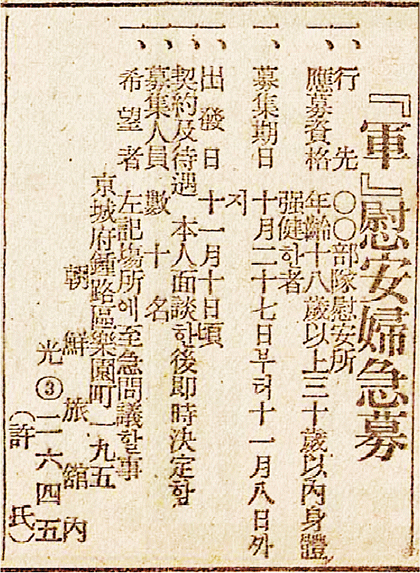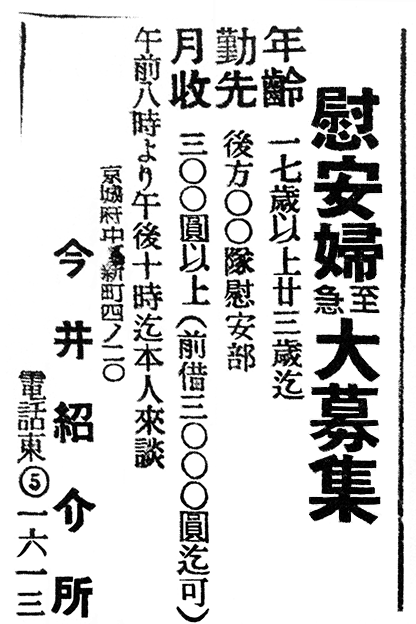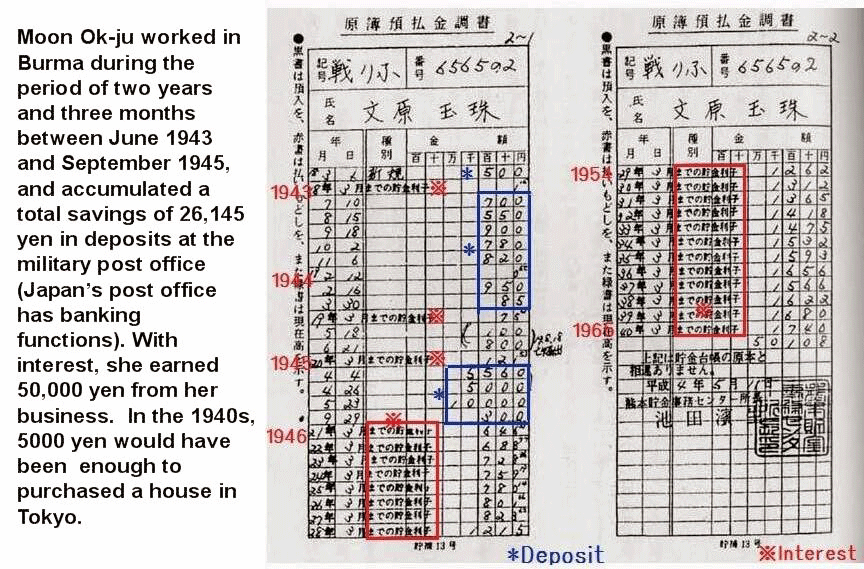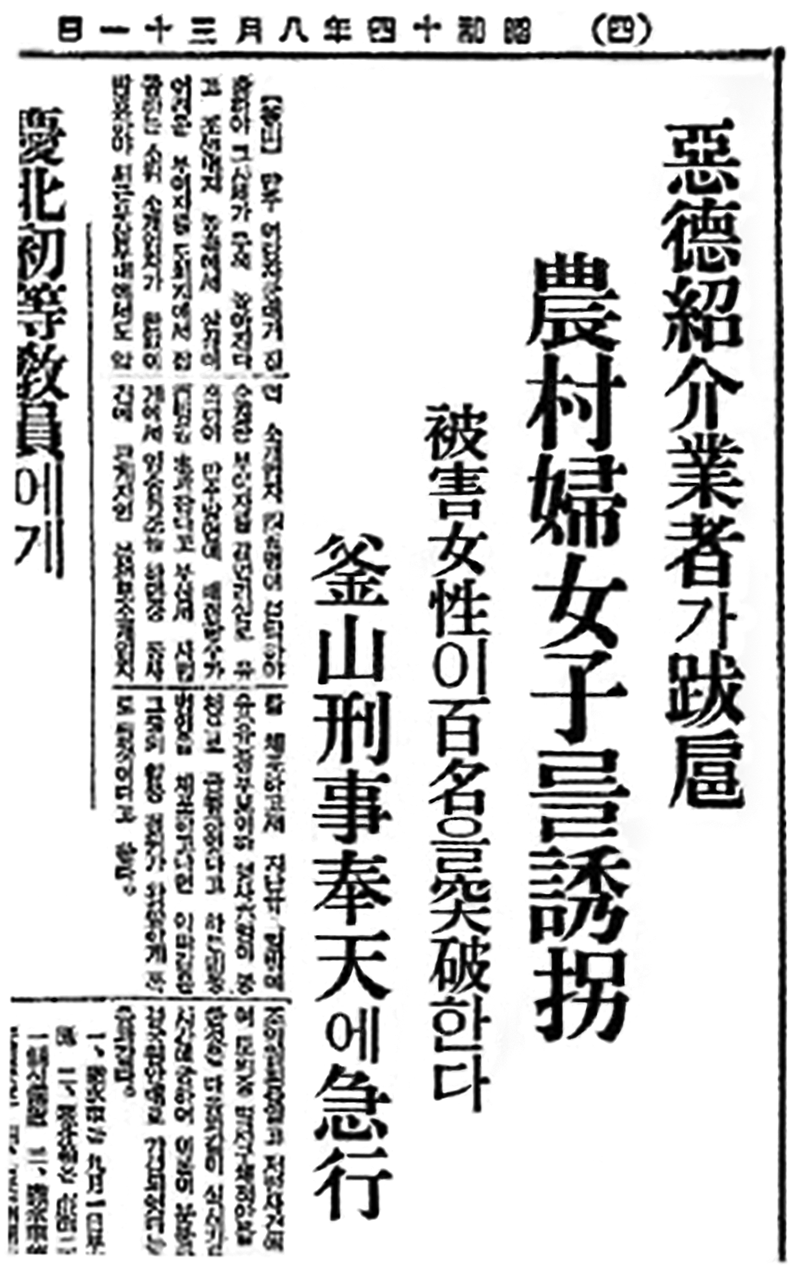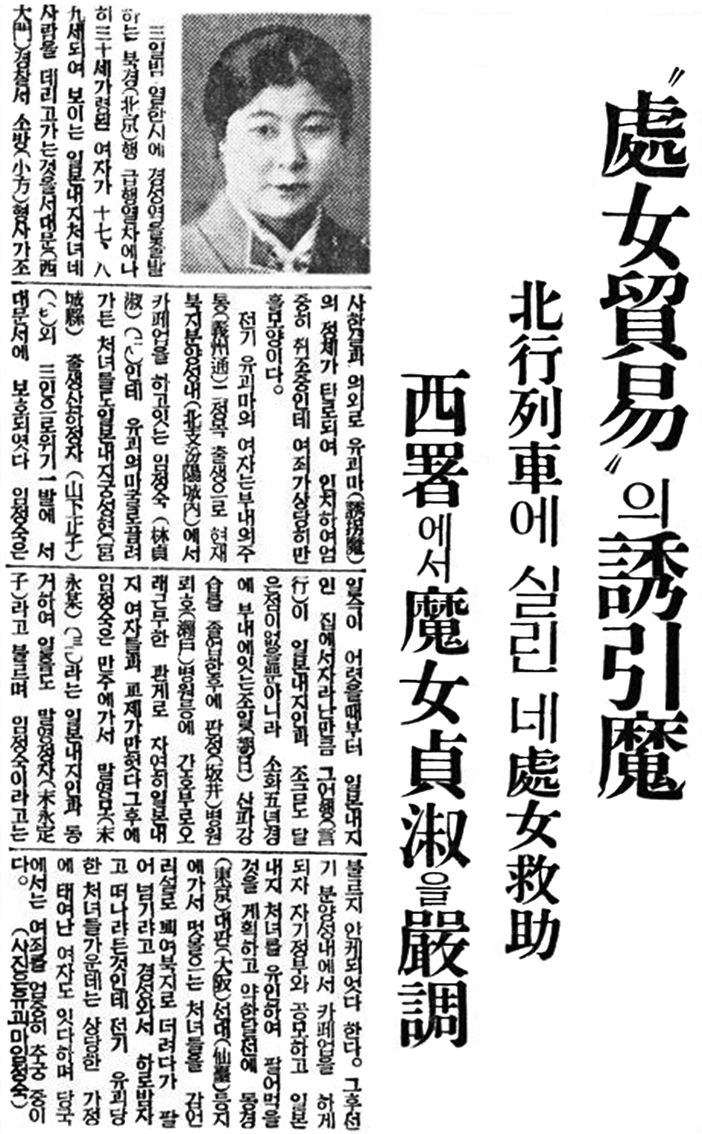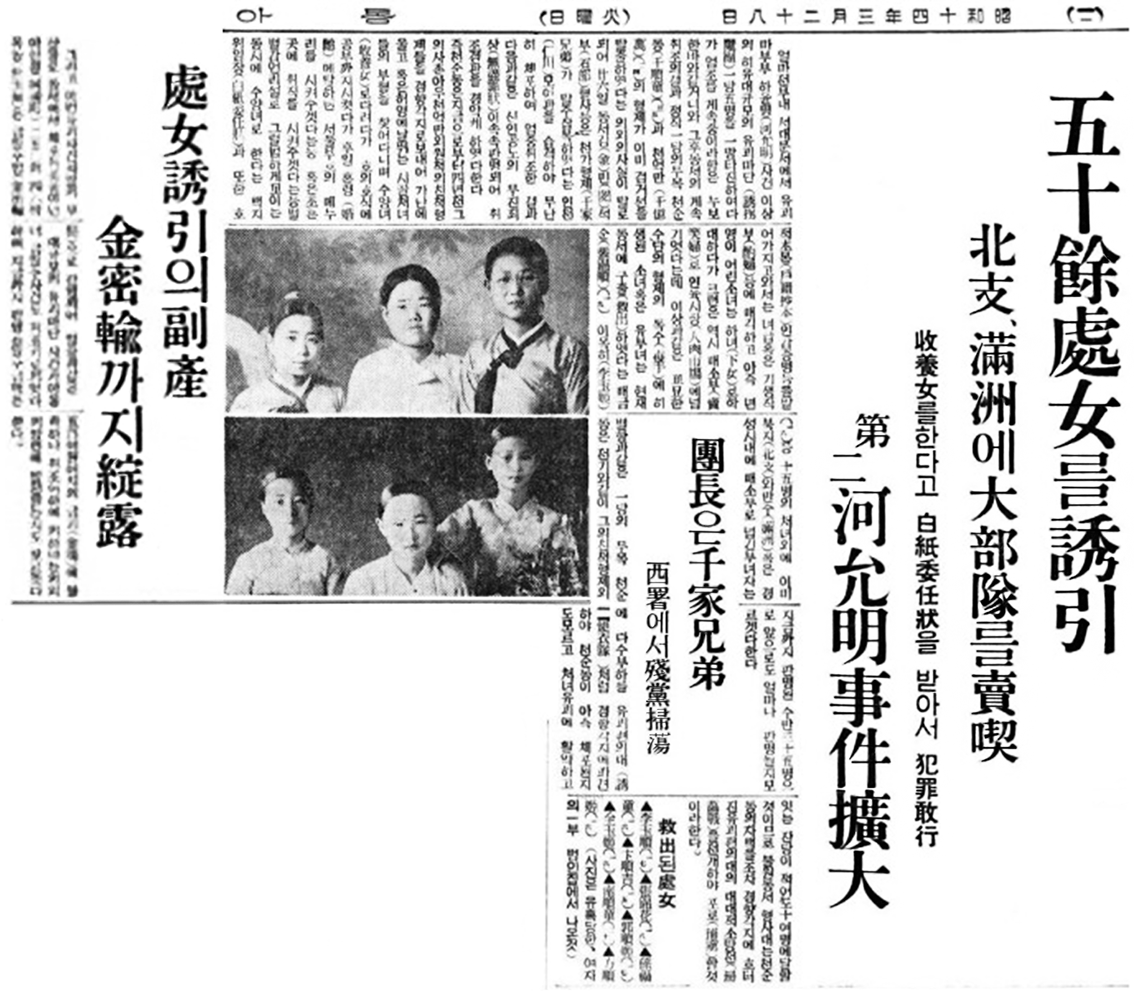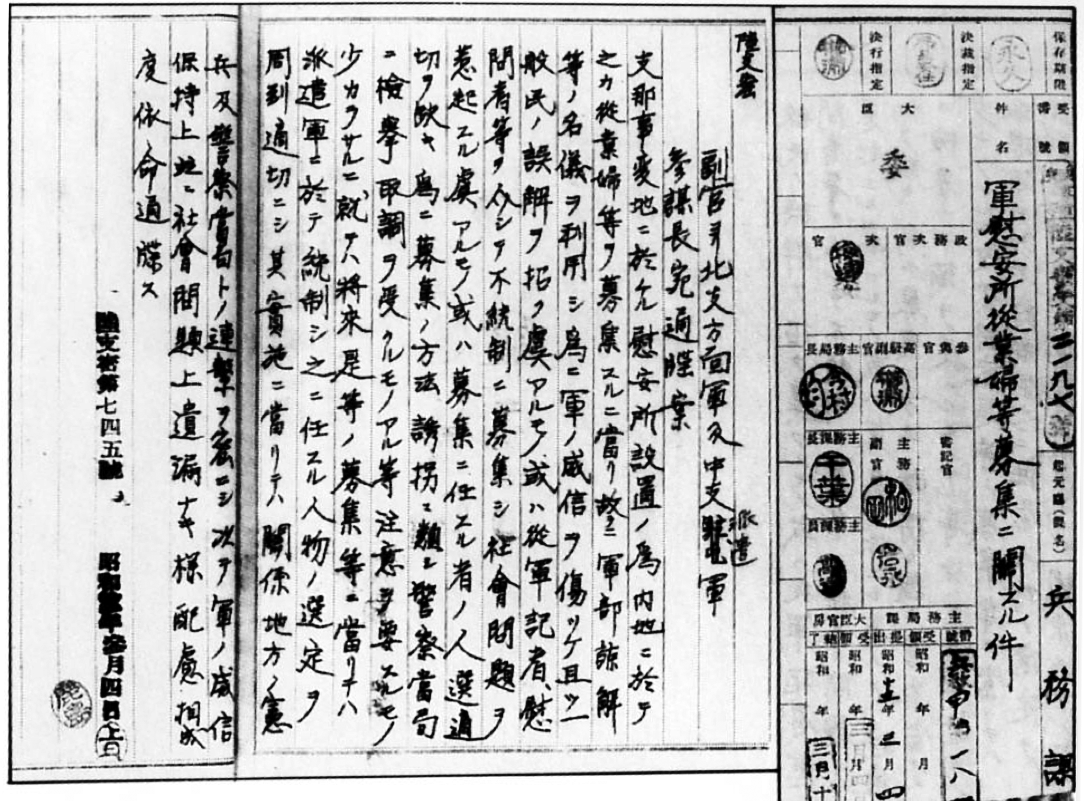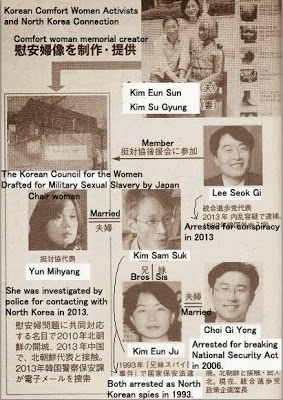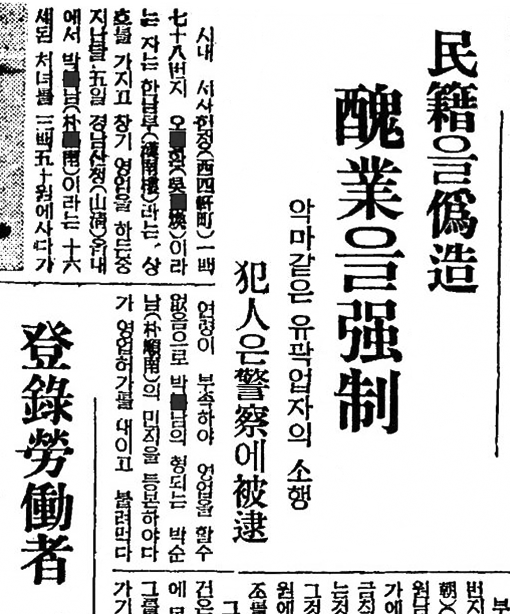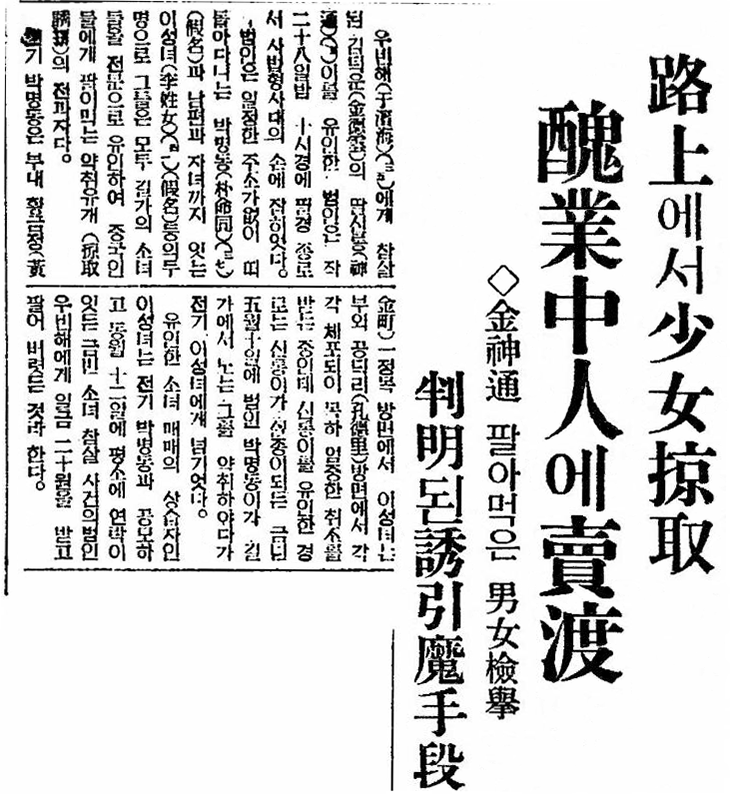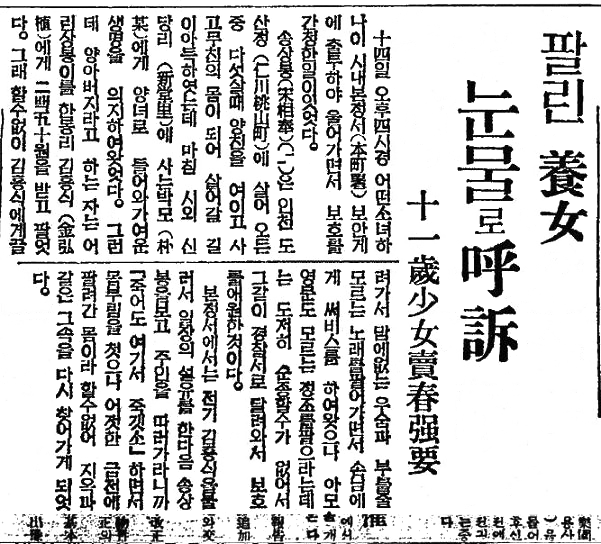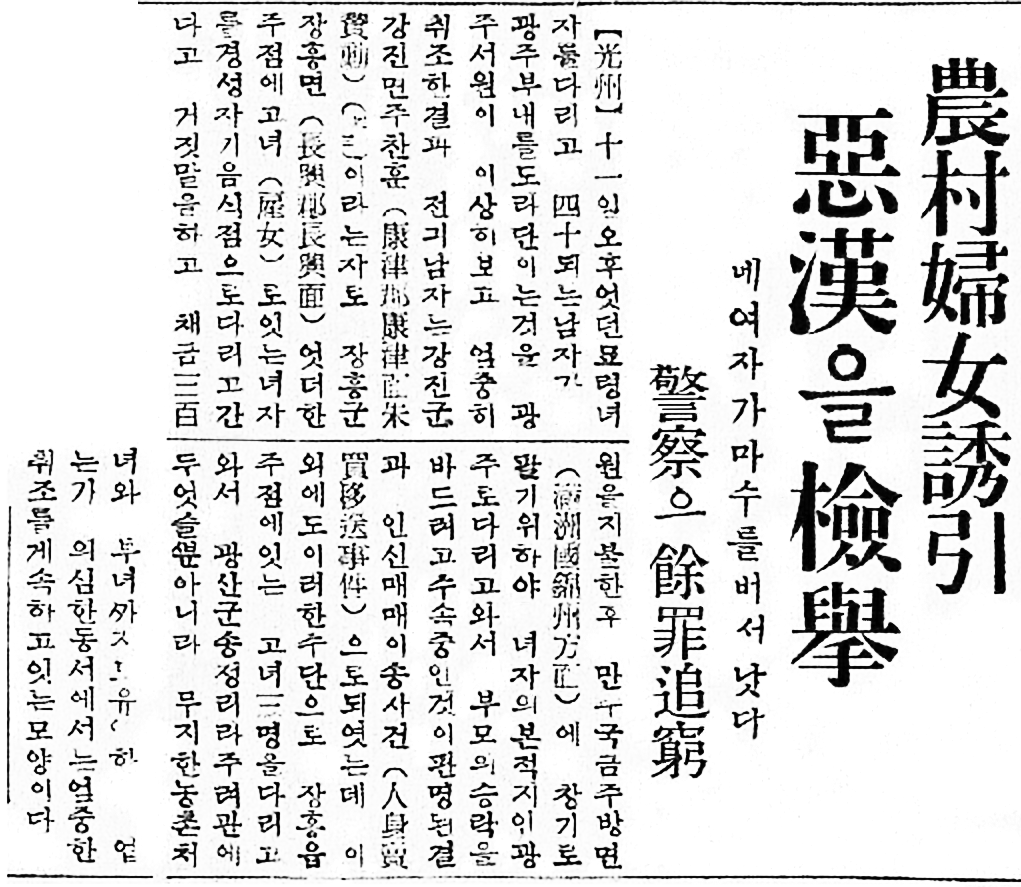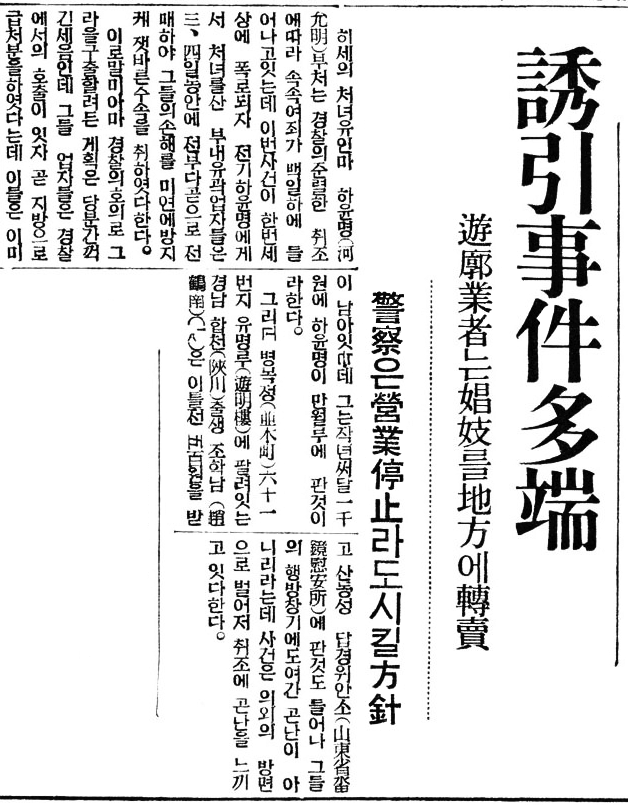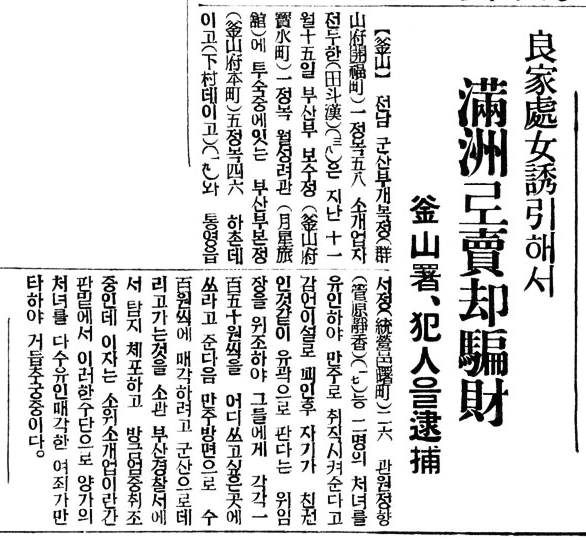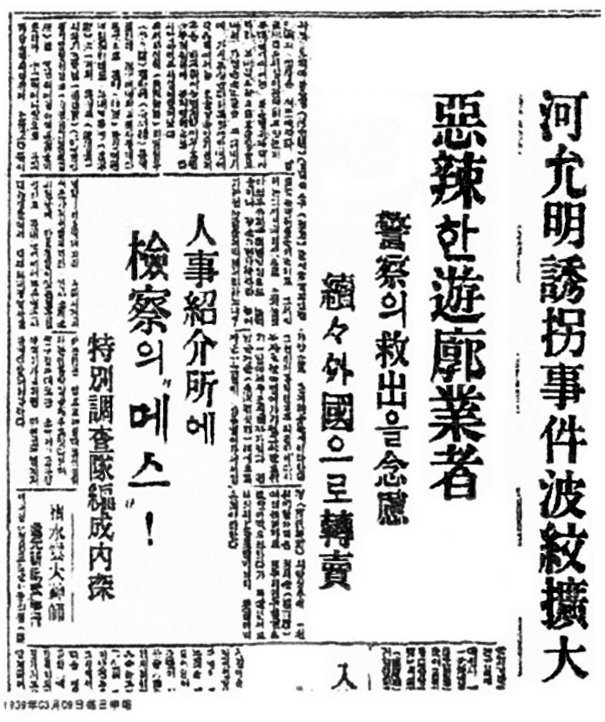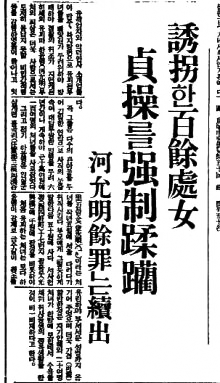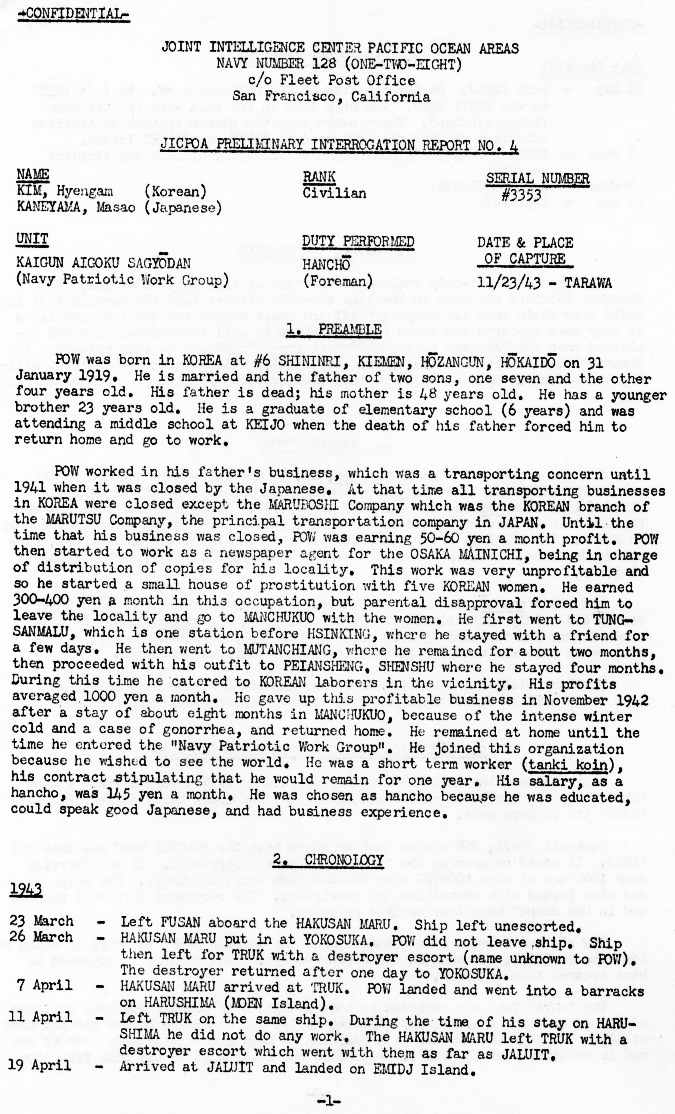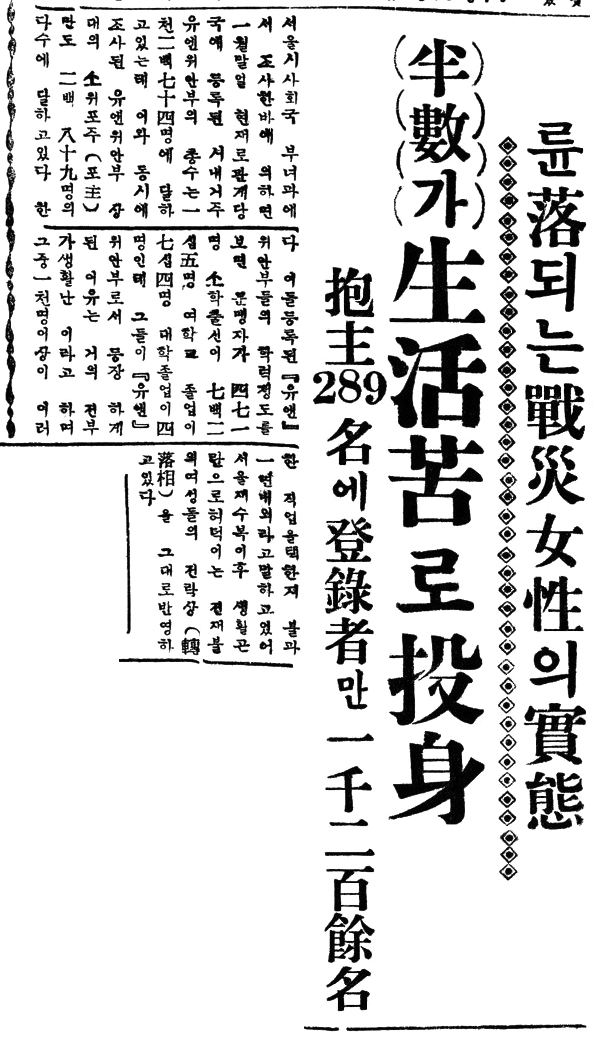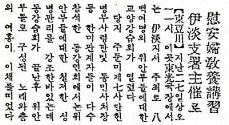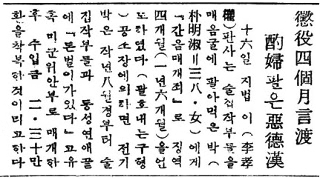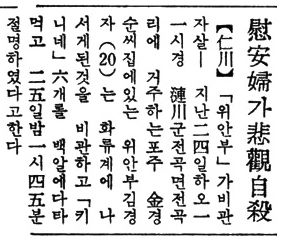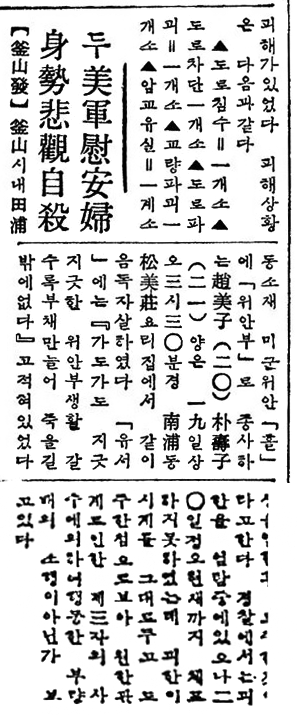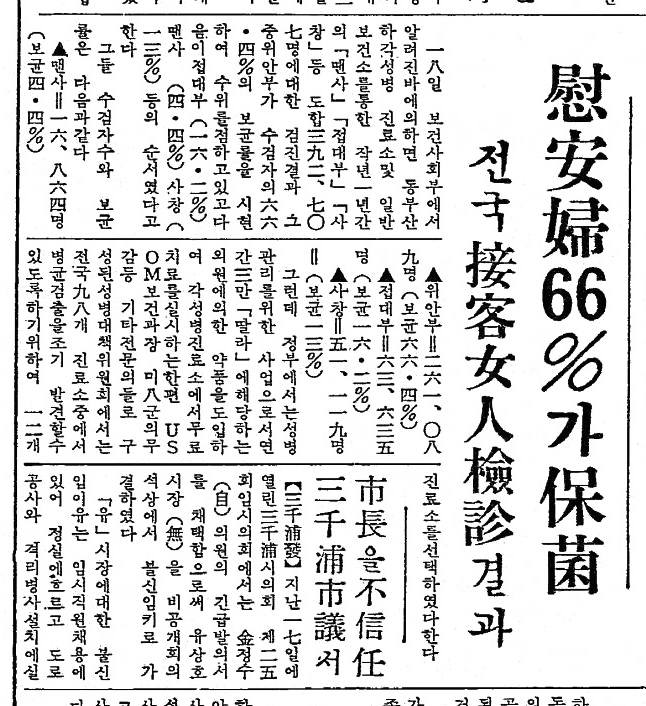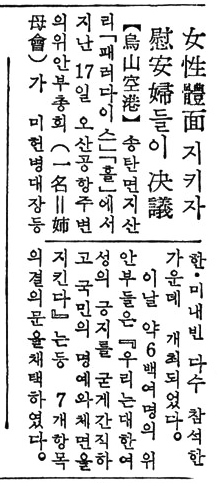Updated July 10, 2021
In the 1990s South Koreans began criticizing Japan for its comfort women system in World War II, but have hardly said anything about its own comfort women system, which begs the question– “If Koreans thought the Japanese comfort women system was so bad, why did the Korean Government set up a similar ‘comfort women’ system, with hundreds of thousands of prostitutes, for UN soldiers after the Japanese left Korea?”
The Korean government was registering women to be prostitutes for UN soldiers stationed in Korea. The US military attended Korean police run training courses for the prostitutes.
One 1959 article below mentions Korean 261,089 comfort women – which is evidence that Korea had a significant number of comfort women. At one time 66% of them were infected with a veneral disease.
Contents
1. Meet Miki Dezaki, Director of the film, Shusenjo: The Main Battleground Of The Comfort Women Issue.
2. Thousands of Korean men and women tricked, kidnapped or forcibly abducted Korean girls to be ‘comfort women’. Statistical Yearbook of the Governor-General of Korea, from 1931-1943.
3. U.S. military documents featuring Korean POW testimony discovered at U.S. National Archives
4. Korean testimony documents highlight ethnic and gender discrimination under Japanese colonial rule
5. “The Comfort Women” (2008) book by Professor C. Sarah Soh (352pp)
6. “Comfort Women of the Empire” the battle over colonial rule and memory (2014)
帝国の慰安婦 植民地支配と記憶の闘い by Professor Park Yu-ha, 박유하, 朴裕河 (336pp)
7. Mun Ok-chu’s memoir
8. Chart of Comfort Station managers, revealing almost all were Korean
9. The Korean comfort station manager’s diary
10. Comfort Women Urgently Wanted – Ads in 1944 Korean newspapers
11. Comfort Women rescued by Japanese military police
12. Kim Tŏk-chin was recruited by Koreans at 17 to be a ‘comfort woman’
Various historical documents and oral histories
13. In 1965 Japan gave $800 million as reparations for Korean occupation
14. Military commentator Ji Man-won raised “fake comfort women” question
Footnotes
1. Professor C. Sarah Soh interviewed at SFSU in 1999
2. Extract Human Dignity and Sexual Culture: A Reflection on the ‘Comfort Women’ Issues by Professor Soh
3. Behind the Comfort Women Controversy: How Lies Became Truth by Professor Nishioka Tsutomu
4. The “Comfort Women” Issue and the Asian Women’s Fund.
5. GSOMIA lives, but what’s next for Japan and South Korea ties? – Japan Times
6. A few more of the hundreds of Korean newspaper reports on the continuous fight against Korean men and women who lured Korean (and Japanese) girls and women into prostitution. There were many arrests of traffickers and hundreds of girls were released.
7. Ex-Prostitutes Say South Korea and U.S. Enabled Sex Trade Near Bases in Korea.
8. Prostitution in Korea after the Korean War, including many newspaper articles from the time.
9. Professor Cho Heung-guk on “The problem of ‘Lai Tai-han’ – The children born between South Korean soldiers and Vietnamese women during the Vietnam war, and a second wave who have been born since diplomatic relations were established between the two countries in 1992. There are estimated to be between 5,000 and 30,000 from the era of the Vietnamese war and they were almost all abandoned.
Here is an article from 1925
This May 11, 1925 article is from the Korean newspaper Dong-A Ilbo and is entitled, “Local Color.” The reporter is describing the Korean city of Cheongjin in North Hamgyeong Province.
Local Color
If you walk down a Korean street in this city, the first thing you notice after one or two houses are signs that say “Boarding House,” “Restaurant,” and “Pawn Shop.” And in every alley you see places with such names as “Seoul House” and “Daegu House” that sell rice wine. You also see many prostitutes in heavy makeup going in and out the doors. However, rather than seeing these establishments as promoting immorality, I see them as places that necessarily exist to provide natural, temporary relief to an increasingly large number of laborers.
Speaking of prostitutes, scores of Korean and Japanese bordellos fill Bukseong-jeong (part of the port city of Cheongjin in Northern Hamgyeong Province ) and have become the town’s specialty product. Whenever military ships, which allow no women onboard, enter the port, it is said that dozens and dozens of sailors race ashore, completely turning the port into a “City of Flesh.” Even when there are no military ships in port, it is said that the streets are bustling with nightlife as sailors are always coming and going.
Most of the buildings along the street are Japanese style. Many of the people on the streets wear Western suits. Hundreds of people leave and enter the city each day. Even many of the locals seem to be wearing Western suits. You hear auctioneers shouting, “five cheon, ten cheon,” and you also hear, “Let’s play, let’s play.” You hear, “The Social system is blah, blah, blah,” and you also hear, “Amen.” All parts of the new and old worlds are represented on the streets of this city.
VIDEO: Meet Miki Dezaki, Director of the film, Shusenjo: The Main Battleground Of The Comfort Women Issue.
An interview with the director of ‘Shusenjo’, a film about the Japanese army’s sexual slavery of women during the 1930s and 40s.
Miki Dezaki, is a Japanese-American. He was a monk in Thailand for a year, and is a former graduate student who edited this film in his dorm house in Tokyo.
Transcript (slightly edited to improve readability)
1:00 Interviewer 1: “… and how you tried to really show those different voices in a very non-judgmental way. What was the trigger for getting interested in this issue?”
Miki Dezak: “I have friends both in Korea and in Japan and I noticed that when they talk to each other about historical issues they always get in arguments all the time. And when I actually started researching the ‘Comfort Women’ issue I realized that there is a huge gap in information between what the Koreans know about the ‘Comfort Women’ issue and what the Japanese people know. Koreans and Japanese people just think the other side is irrational and is [being too] emotional. Through my film, hopefully people can realize that there is a reason why Koreans are angry and there is a reason why Japanese people don’t know a lot about the ‘Comfort Women’ issue. And maybe it’s not the best solution to just get angry at each other but maybe through [a deeper] understanding they can have better discussions [together].”
1:56 Interviewer 1: “OK, so one of the recent issues has been over the ‘GSOMIA’ (General Security of Military Information Agreement) [see link to Japan Times article below].
Miki Dezak: “I think the first move was by Abe, to be honest. He took that forced labor verdict and turned it into a diplomatic issue, whereas it was really a human rights issue it’s a civil case. And then Korea, the people retaliated by boycotting – which I thought was a really great move – it showed the people power thing. Unfortunately, I knew that it was going to be spun in Japan – ‘Oh, Korea is being irrational again’. Now I think this retaliation by President Moon is also going to be seen as that. Prime Minister Abe likes to create an enemy, to foster more and more ill sentiment towards each other. He gains more support that way. His main goal is really to change the [Japanese] constitution so they can remilitarize. So now we have a destabilized region. Now people in Japan might be like, Oh, OK, maybe we do need a military now.
3:11 Interviewer 1: “It was changed to ‘No Abe’”
3:16 Miki Dezak: “That is a good kind of approach to differentiate between Japan as a whole and Abe. When you say ‘No Abe,’ or we don’t agree with Abe’s policies, actually Japanese people can get behind that as well. So Korean and Japanese people can support that; [both] don’t agree with Abe’s policies.”
Interviewer 1: “It’s very dangerous to generalize too much.”
Miki Dezak: “Yeah, yeah”
Interviewer 1: “What was the key message you wanted to [get across]?”
Miki Dezak: “I would say for the Korean audience, be aware of the information that they haven’t received. They have heard a lot about the ‘Comfort Women’ issue, in the news and in the media, but what was the information that was left out, and why was that left out? The Korean media oftentimes tends to focus on the most extreme cases.”
4:10 “A lot of Koreans think that Japan has never apologized, but that actually is not true. They actually apologized many, many times. I wouldn’t say that the apologies were full apologies. But some of them, especially in the 1990s, were actually quite sincere. In the Kono Statement they really acknowledged the ‘Comfort Women’ system and Japan apologized and promised to teach the history of the Comfort Women. Now they have kind of gone back on that because they don’t teach it very much anymore.
So it is interesting, Japanese people and the media basically say ‘You can’t really trust Koreans because they backed out of the 2015 Comfort Women Agreement’. Basically Japan has backed out of the Kono Statement by not teaching the history of the ‘Comfort Women’ – but they never talk about that in the Japanese media.”
Interviewer 1: “I think in Germany, for example, after the apologies of Brandt or other people, they continued to produce common textbooks between the German, French and Polish people and taught about the [problematic things that were done during World War II]. The apology is only the first point and it is the point of departure to develop friendly relationships with other countries. But in Japan, for example, the Abe government have erased [the problematic things of World War II]. You have the Kono Statement, and then what comes after it?”
Miki Dezak: “Right, exactly. Since the Kono Statement there was a huge movement to erase the [problematic] history.”
Abe video clip
5:40 “Actually even Abe says, ‘Oh we uphold the Kono Statement’ – every year, basically. It’s really strategic, I think. When he says he upholds the Kono Statement, that tells the Japanese people, Oh OK, we’re doing the right thing, but in the background he is saying, take down the statues, we don’t teach the ‘Comfort Women’ issue.”
6:05 Interviewer 2: “Why do you think they are doing this? Why do they try to erase [parts of] the history?”
6:11 Miki Dezak: “There are two ways to look at patriotism. Actually a lot of the left-wingers in my movie say they do what they do because they love their country. They want it to get better. They want to see the horrible things that they have done in the past, and to reflect on them and then to get better as a country. Whereas the right-wingers, the nationalists, see patriotism as like you deny all those horrible things and you believe this kind of myth that Japan is superior and amazing and honorable.”
6:44 Interviewer 1: “I once had an interview with Professor Hosaka Yuji. He mentioned that one of the reasons why Japan does not apologize, or is inconsistent with its apologies, is to a certain extent because they have a ‘Samurai mentality’ [meaning] that you don’t actually give in. So in Japan, for example, when they lost World War II, 500 war criminals actually went into a room and committed suicide. Giving in and saying we made a mistake and we’re really sorry to a certain extent shows weakness. Do you think that is true?”
7:15: Miki Dezak: “I think it is hard for Japan to give in when they feel superior to Korea. People say if you apologize for the ‘Comfort Women’ then you have to apologize for the forced labor, then maybe you have to give up the islands [between Japan and Korea that are claimed by both sides]. But I think those situations are all very different. You could still apologize for the ‘Comfort Women’ issue and not necessarily apologize for the forced labor because the forced labor was not necessarily a government run system. It was more private companies that did that kind of forced labor. Their view of history is that Japan has never done anything wrong. They were not the aggressors in the war; they were defending themselves and liberating Asia. So that is why, I think, it’s really hard [for them] to apologize.”
8:05 Interviewer 1: “How was the reaction to your movie in Japan? Aren’t you afraid?”
Miki Dezak: “There is always a big concern because I criticize these huge powerful people. So these days when I walk around in Japan I [go] in disguise. But surprisingly though, the reception to the film has been very good. They show that they are not going to give in to these right-wingers any more.”
Quote: “These people are historical revisionists or denialists.”
8:45 Interviewer 1: “We have them in Germany as well. Holocaust denialists and everything.”
Interviewer 2: “I didn’t know there was actual organization in these groups who just yell about it. But do they actually have seriously funded organizations?”
Miki Dezak: “Yeah, of course they have a lot of funds. I think the difference between Japan and Germany is that denialism is actually illegal in Germany. You can’t do these things. And if there are denialists, they are a very small group. Whereas in Japan, denialism or historically revized history about the ‘Comfort Women’ issue is mainstream. That is what most people [in Japan] know about the ‘Comfort Women’ issue. My Mom used to think that way. (People who) don’t really know about the ‘Comfort Women’ issue, they just accept what the media has said to them, which is the right-wing perspective.”
9:35 Interviewer 2: “The ‘Comfort Women’ issue is a human rights issue, which is an international issue.”
Miki Dezak: “For sure”
9:41 Interviewer 2: “I think that sums up everything so well.”
Miki Dezak: “It is a symbol, right. Then in which direction are we going as a global community? So if you can’t give these women their justice, then we are really going backwards in time.”
10:02 Interviewer 2: “As a foreigner living in Korea I am sometimes confused if I am allowed to talk about anything that has to do with the history that has happened here. I heard that man say it and it made me feel more comfortable, and it gave me encouragement, and more power. [I think] people should talk more about this.
Miki Dezak: “I hope Korean people do not see this as Japan versus Korea. It’s actually people who support human rights versus those who are trying to deny those rights.”
Several important books have been written about the Comfort Women issue, and there are many historical documents from the 1930s and 40s. Statistics from Korea are very revealing:
Thousands of Korean men and women tricked, kidnapped or forcibly abducted Korean girls to be ‘comfort women’.
朝鮮半島で朝鮮人女性を騙したり誘拐したりして強制連行したのはほとんど朝鮮人ですから
Statistical Yearbook of the Governor-General of Korea, from 1931
朝鮮総督府統計年報. 昭和 13年
Abduction and Kidnapping 略取及誘拐
Number of crimes where arrests were made 犯罪件数検挙
Number of completed or cleared cases, people in custody 検挙件数 検挙者
Crime of abduction and kidnapping 略取及び誘拐の罪
True Stories of the Korean Comfort Women
The Korean Council for Women Drafted for Military Sexual Slavery by Japan
Edited by Keith Howard
lecturer in Korean Studies at the School of Oriental and African Studies, University of London.
Testimonies compiled by the Korean Council for Women Drafted for Military Sexual Slavery by Japan and Research Association on the Women Drafted for Military Sexual Slavery by Japan, and translated by Young Joo Lee.
Korean published 1993, English translation published 1995
page 23
After the War
Although the Japanese military exploited comfort women to such an extent, hardly any were taken back to Japan after the war. The treatment received by the women after Japan capitulated was in a way much more cruel than what they had been subjected to when they were initially drafted or when they later worked in the comfort stations. Many soldiers have stated that women were abandoned in their stations, were forced to take their own lives along with soldiers or were taken to caves or submarines and murdered.
Among those interviewed here, eight were able to leave their comfort stations before the war ended. Two ran away, one was sent home because she had a serious venereal disease, four received travel passes with the help of officers they had grown close to and one returned home with her proprietor. One went back to her first comfort station, and a total of 12 were able to return to Korea once the war ended. Only one of the 12 who returned to Korea initially left her comfort station with Japanese soldiers, while the other 11 say that soldiers simply suddenly stopped coming to the station. After the soldiers fled, abandoned women found their own way home or stayed in American refugee camps before they were shipped to Korea.
Those who had been comfort women suffered greatly back in Korea. They still suffered from diseases they had contracted while working in the comfort stations. They bore guilty consciences, simply because of the knowledge that they had been prostitutes. They suffered from the prejudice and discrimination of their relatives and friends. Many still had venereal disease or from time to time suffered its recurrence. The son of one became mentally disordered because his mother had venereal infection at the time of conception. Many women subsequently found they were barren, and many still suffer from ailments, from womb infections, high blood pressure, stomach trouble, heart trouble, nervous breakdowns, mental illness and so on. The psychological aftermath is far more serious than the physical suffering endured in the comfort stations. Apart from nervous breakdowns or mental disorders, the effects of which can be noticed externally, the minds of former comfort women are haunted by delusions of persecution, shame and inferiority. They tend to retain a distrust and hatred of men. They want to avoid contact with other human beings. Taken together, all of these make it difficult for the women to carry on any normal social life. The prejudice and discrimination heaped on them by society makes them feel particularly wretched. People around the women tend to despise them, guessing even if never told that they were sexually victimized while abroad. One woman we interviewed was thrown out of her house when her husband discovered the secrets of her past.
According to our research, women were most resentful of the fact that they were unable to lead ordinary married lives after their return. Six of the women we interviewed married, and five became second wives. But all marriages failed. Eight experienced some form of family life by moving in with men without marrying, but most of these relationships also ended in breakdown. Five women never married. Only two live with their own children; one stays with an adopted son, and one with a grandchild. The remaining 15 women now live on their own. All once tried to make a living on their own. They have, however, suffered from poor physical and mental health, hence work is difficult and all have consequently endured great financial difficulties. The women managed to survive an extremely harsh life on the battlefields of a foreign war, but the reality they have been forced to face since their return to Korea in peacetime has been nothing short of a continuation of their hardship, even though in a different form.
page 65
Oh Omok
Oh Omok was born in 1921, in Chŏngŭp, North Chŏlla province, the first child in a poor family of five children, two boys and three girls. In 1937, at 16 years of age, she was promised work in a textile factory in Japan by a Mr Kim from her home town. She left home with a friend. When they arrived in Manchuria, where Mr Kim handed them over to a Japanese man, they were taken to a Japanese unit and forced to become comfort women.
I was born into a poor family on 15 January 1921, in Chŏngŭp, North Chŏlla province. I was the eldest child, and I soon gained two brothers and two sisters. My father had been in poor health since I was very little and was now no longer able to work. My mother ran a small shop next to the police station where she sold vegetables. I couldn’t go to school, because we were too poor to pay the fees.
It was 1937, and I was 16. My parents had begun to try to find me a husband. One day a Mr Kim, from Chŏngŭp, visited us and said that he could get me a job in a textile factory in Japan. He also offered to find work for a friend of mine. He said that our job would be as weavers and added that we would be paid such and such a month. I forget the actual amount. After the visit he didn’t come back. We had almost forgotten about him when he suddenly reappeared and urged me to take the job which was on offer. I needed to earn money, so I went along with him, taking an old friend of mine called Okhŭi. She was two years younger than me. She used to visit me often and I had shown her how to embroider.
When I left home for the factory, my mother was expecting another child. It must have been winter, since I remember wearing padded clothes. Okhŭi and I arrived at Chŏngŭp station with Mr Kim, where there were three other girls waiting. We all got on board a train and travelled to Taejon, where Mr Kim bought us lunch. Then we boarded the train again and travelled for three or four days, all the way to Manchuria. Somewhere around Fengcheng we asked Mr Kim why he had brought us to China instead of Japan. He had, after all, promised to take us to Japan. He bluntly told us we must follow him. He handed us over to a Japanese man and promptly disappeared. From then on, with this new man, we continued our journey further north until we finally arrived right at the top-most tip of Manchuria, although I still don’t know what the place was called. It was very cold, and it was crowded with soldiers. There were mountains and rivers, and there were thousands of Chinese and Koreans milling around.
The five of us from Chŏngŭp were led to a village of tents on the outskirts of the place where the Japanese military units were based. There was a sea of tents surrounding the troops. Whenever new soldiers arrived, they would set up even more tents, because there was not enough room for them in the barracks that had already been built. There were already some 30 Korean women. We entered one tent. A soldier there cut my hair short and gave me a Japanese name, Masako.
There were women in every tent. They washed the soldiers’ clothes and they cooked for them in the kitchens. There was no fresh water supply in the whole village. The soldiers delivered meals to us. We had cooked rice mixed with barley, spinach or pickled radish, soup and occasional fish balls. We could often hear guns firing in the distance, and whenever there were air raids we were not allowed to light anything.
At first I delivered food for the soldiers and had to serve the rank and file, to have sex with them. There were Japanese as well as Koreans among the managers who instructed us where to go each day. On receiving orders we were called to the appropriate unit and served five or six men a day. At times we would serve up to ten. We served the soldiers in very small rooms with floors covered with Japanese-style mats, tatami. There were many rooms. We lived in the tents and were summoned to the barracks whenever required. We were given blankets by the army, and when it was very cold we used hot water tins. The only toilets were outside the tents, as were the bathrooms, and such facilities were separated for men and women. When the soldiers were away on an expedition it was nice and quiet, but once they returned we had to serve many of them. Then they would come to our rooms in a continuous stream. I wept a lot in the early days. Some soldiers tried to comfort me saying ‘kawaisōni or ‘naitara ikanyo’ which meant something like ‘you poor thing’ and ‘don’t cry’. Some of the soldiers would hit me because I didn’t understand their language. If we displeased them in the slightest way they shouted at us and beat us: ‘bakayarō’ or ‘kisamayaro’, ‘you idiot’ and ‘you bastard’. I realized that I must do whatever they wanted of me if I wished to survive. There was no payment given to any of us for cooking or washing clothes, but we were paid whenever we slept with soldiers. The bills they handed over were blue and red. There were some women who set up home with soldiers in tents, and a few of them even had children.
The soldiers used condoms. We had to have a medical examination for venereal infections once a week. Those infected took medicine and were injected with ‘No. 606’. Sometime later, I became quite close to a Lieutenant Morimoto, who arranged for Okhŭi and me to receive only high-ranking officers. Once we began to exclusively serve lieutenants and second lieutenants, our lives became much easier. When I was 21, in 1941, I had to have my appendix out, but the operation didn’t go well and I was readmitted to hospital for a second, follow-up operation. I remember Morimoto coming to see me. The hospital chief was Japanese, and the patients were mostly soldiers and Chinese women. The fee for the operations must have been paid by the army. Afterwards I was able to take a break from serving soldiers. During my convalescence I did various chores: I cooked, filled bathtubs, heated the bath water and so forth.
We moved along with the army. I cannot remember what it was called. We moved south in China. When we were stationed in Nanjing we were sometimes able to see films with the soldiers. We mainly watched war films. The comfort station there was housed in a Chinese building. It was not so cold there. We wore Western style dresses and occasionally were able to buy Chinese clothes. Fukiko, Masako and Fumiko were among the five of us who went there together, but all the others died except Fukiko. One of them died of serious syphilis. There was a sign in front of the house, but I don’t remember what it said. In Nanjing we had to serve many soldiers, just as usual. Whenever they came into the building, we had to say ‘irassyai’. This meant ‘welcome’. There was a bed and a mirror in each room.
I cannot remember where it was, but we had to do training under the supervision of the soldiers. Each of us wore a sash on our shoulder with Women’s National Defence Society written on it. We wore caps and baggy black trousers. There were Japanese women and civilians who trained with us, and after each training session we returned to our station.
It was while we were there that we were liberated. There was a Korean man from Kwangju who lived in Nanjing with his wife and family, trying to run a business. I used to call him my big brother, and we got on very well. After Korea was liberated Okhŭi and I returned with this man and his family. On our way back, many people with us died in a train accident, but we were delivered safely. I wept and wept as we travelled back to our homeland, and ‘big brother’ tried to console me. He, with his wife and family, went their own way half-way through the journey, and Okhŭi and I were left alone. We noticed lots and lots of Russian troops on the way, and there was a rumour going around that they would take away young women, just as the Japanese had done before them. So we smudged our faces with soot, and continued our journey looking like tramps. In Shinŭiju we stayed overnight in a Korean guest-house. Russian soldiers rushed in during the night, apparently looking for young women, so we hid in a wardrobe. They must have gone, but we stayed confined in there all night.
We got on a ship from Shinŭiju to Inch’ŏn, and then took a train to Chŏngŭp. I was wearing flat yellow shoes I had bought in China, and a short-sleeved blouse. We bid goodbye to each other at the station, and I took a rickshaw home. My brother, Kŭmsu, who was in primary school at the time, still remembers me arriving on the rickshaw! My other brother was cutting firewood, and when he heard I was home he dropped everything and ran back to the house. My parents said that they had given me up for dead. My mother was so shocked to see me after such a long time that she fainted. After nine years in China, I found it hard at first to understand my own language. I had a small bamboo bag from Japan with me in which I carried some photographs and Chinese shoes. But in order to forget that part of my life, I burnt these souvenirs later on.
For a few years I stayed with my parents. I lied to them about my life in China, saying I had worked as a domestic help. I was still young, and felt that I could do anything with my life. My parents tried to find me a husband, but I said I wanted to live alone. They finally found me a room, and my mother bought me a pair of beautiful shoes, even though she was still very poor. She also got me many herbal cordials to build up my strength. After 1945, my parents were running a small restaurant in a boarding house for policemen. My father died of illness in 1951, and at the age of 33 I married a farmer whose wife had also died. I had been told that he had two children from his first wife, but after the marriage I found out that he had five! Marrying him meant I had to move to Seoul, and I lived with him for a number of years, looking after those five children. I found it hard to bring up someone else’s kids, and I soon discovered that I wasn’t able to have any of my own. When I was 48 I left him, taking with me the baby of my housemaid. I adopted that baby girl and lived back in Chŏngŭp for three years, without letting anyone know my exact whereabouts, not even my own brothers. It was hard to bring up a child on my own. I lived on cooked barley, working at silkworm farms on a daily wage of 2500 wŏn. I could not afford to send my adopted daughter to school until she was nine but, seeing me struggling to survive, she left school during her sixth grade and began to work in a factory that made bamboo umbrellas. I didn’t tell her that she had been adopted, just that her father had died. She is 21 now, married to a stonemason. They live in Asan county, South Ch’ungch’ŏng province. They have a three-year-old son and are expecting a second child soon. So that they were able to register the birth of their child, I had to register the birth of my adopted daughter as my own daughter. I had been scared to do this earlier.
Okhŭi used to say that, since we couldn’t have children or be married, we should live on our own. She used to visit me often and we would cry together, talking about our miserable past. She, too, lived on government aid until she died of cancer last year. I have been on the list to receive state benefit for the past three years. In the autumn I work, picking red peppers from their stalks. If I work from dawn until dusk, I get paid something between 3000 and 5000 wŏn ($4 to $6) a day. I have very little income, so I don’t pay any tax, but I have to pay 300,000 wŏn ($375) every ten months for my room. Last year I wasn’t able to pay it. My only wish is to be able to live without worrying about rent. And I still feel resentful that I haven’t been able to have children because of what happened almost 50 years ago.
http://mainichi.jp/english/articles/20160610/p2a/00m/0na/015000c
U.S. military documents featuring Korean POW testimony discovered at U.S. National Archives
Documents containing testimony on Japanese rule and wartime mobilization from Korean civilians who had been with the Imperial Japanese Army prior to their capture as prisoners of war (POWs) by U.S. Forces toward the end of the Pacific War have been discovered at the U.S. National Archives, and are expected to reignite debate regarding forced laborers and so-called “comfort women.”
The Asian Women’s Fund – established by the Japanese government in 1995 and run through 2007 in an effort to resolve the “comfort women” issue – set up a committee on gathering historical documents, which in 1997 found the responses given by the POWs during investigative research in the U.S. The documents subsequently went missing, but were located again this year when Waseda University professor Toyomi Asano, who specializes in Japanese political history, together with the Mainichi Shimbun, found in March the documents containing the U.S. military’s questions and other related information.
After the U.S. military interrogated around 100 Korean prisoners, they chose three whom they transported to an interrogation center at Camp Tracy in California for further questioning. The documents indicate that the three prisoners were asked 30 additional questions on April 11, 1945.
Both the names of the interrogators and the prisoners are indicated on the documents, and the answers given by the three prisoners are compiled as single answers. The preamble to the prisoners’ answers states, “The general anti-Japanese feeling of these Koreans is the same as almost all of some 100 prisoners of war questioned by the interrogator,” adding, “It is probably that some Koreans are opportunists but these three appear to be very sincere in their statements which may be considered reliable.”
As for questioning regarding so-called “comfort women,” the three prisoners were asked, “Do Koreans generally know about the recruitment of Korean girls by the Japanese Army to serve as prostitutes? What is the attitude of the average Korean toward this program? Does the P/W know of any disturbances or friction which has grown out of this program?”
The three prisoners are recorded as having responded, “All Korean prostitutes that PoW have seen in the Pacific were volunteers or had been sold by their parents into prostitution. This is proper in the Korean way of thinking but direct conscription of women by the Japanese would be an outrage that the old and young alike would not tolerate. Men would rise up in rage, killing Japanese no matter what consequence they might suffer.”
In response to a question about the procedures through which Korean laborers were sent to Japan Proper, and whether they arrived in Japan Proper voluntarily or were conscripted, the three prisoners said that “Korean men (had) been conscripted to work in Japan since 1942,” and that they knew people “working in coal and iron mines, and building airfields.” They also said that “they were always required to do the worst type of work such as was found in the deepest and hottest part of a mine.” Meanwhile, they said they were allowed to correspond with family, but that “all mail was censored.”
Much of U.S. military interrogations of POWs were of Japanese nationals, and testimonies given by Koreans are rare. Among interrogations of “comfort women,” there is a report compiled through questioning of Korean “comfort women” who were captured in Burma (present-day Myanmar) as the result of U.S. military psychological operations (PSYOPs). The most recently discovered documents are an extension of that report, and are believed to have been an effort by the U.S. military to feel out the level of Koreans’ defiance toward Japanese colonial rule with an eye to seizing the Korean Peninsula.
Korean POW testimony documents discovered at U.S. National Archives (PDF file) :
http://cdn.mainichi.jp/vol1/2016/06/10/20160610p2a00m0na015000q/0.pdf
http://mainichi.jp/english/articles/20160610/p2a/00m/0na/018000c
Korean testimony docs highlight ethnic, gender discrimination under Japanese colonial rule
Testimonies given by Korean civilians to U.S. military officials on their treatment under Japanese colonial rule, which were recently re-discovered at the U.S. National Archives, highlight the ethnic and gender discrimination that governed Japanese policy at the time. …
The interrogations are valuable also for having been conducted at a time when the prisoners did not know where the war was headed, were under little pressure, and had a fair amount of freedom. The testimonies represent the sentiments of the lowest ranks of Korean society at the time. …
They also said that had there been explicitly forced conscription of so-called “comfort women,” the Korean people would be infuriated. …
According to testimonies from former “comfort women,” we know that there were many cases of women being defrauded into becoming “comfort women” after they were told they’d be given lucrative work. The sexism ingrained in society and the poverty faced by the Korean peninsula under Japanese colonial rule made it particularly easy to commit such employment fraud. …
http://scholarsinenglish.blogspot.com/2014/10/the-comfort-women-by-chunghee-sarah-soh.html
“The Comfort Women” by Professor C. Sarah Soh
from the back cover:
In an era marked by atrocities perpetrated on a grand scale, the tragedy of the so-called comfort women – mostly Korean women forced into prostitution by the Japanese army – endures as one of the darkest events of World War II. These women have usually been labeled victims of a war crime, a simplistic view that makes it easy to pin blame on the policies of imperial Japan and therefore easier to consign the episode to a war-torn past. In this revelatory study, C. Sarah Soh provocatively disputes this master narrative.
Soh reveals that the forces of Japanese colonialism and Korean patriarchy together shaped the fate of Korean comfort women – a double bind made strikingly apparent in the cases of women cast into sexual slavery after fleeing abuse at home. Other victims were press-ganged into prostitution, sometimes with the help of Korean procurers. Drawing on historical research and interviews with survivors, Soh tells the stories of these women from girlhood through their subjugation and beyond to their efforts to overcome the traumas of their past. Finally, Soh examines the array of factors – from South Korean nationalist politics politics to the aims of the international women’s human rights movement – that have contributed to the incomplete view of the tragedy that still dominates today.
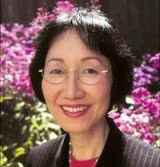
Professor Chunghee Sarah Soh was born in South Korea and graduated from Sogang University there. She then moved to the United States and received her Ph.D. in anthropology from University of Hawaii. She is a professor of anthropology at San Francisco State University.
In this book, Professor Soh criticizes the South Korean activist group “Korean Council” (also known as Chong Dae Hyup 정대협 挺対協 in Korean) for spreading North Korean propaganda and using the comfort women issue to block reconciliation between Japan and South Korea. She insists that Korean society must repudiate victimization, admit its complicity and accept that the system was not criminal. She also argues that the case of a small number of Dutch and Filipino women who were coerced by lower ranked Japanese soldiers in the battlefields was an anomaly, and that most women (Japanese, Korean and Taiwanese) were recruited and employed by prostitution brokers.
The following is an excerpt from her book “The Comfort Women.” (Pages 10-11)
By 1920 some Korean women had become “overseas prostitutes.” Those who worked at a restaurant in Sapporo, Japan, became what Yun Chǒng-ok calls “industrial comfort women,” serving Korean men who worked there.43 When the adult entertainment business in Korea suffered as a result of the Great Depression of the 1920s, female workers and business owners migrated to China. By the late 1920s the capital of colonial Korea, Kyǒngsǒng, was home to four pleasure quarters, which employed a total of 4,295 prostitutes.44 By the mid-1930s 45 percent of Koreans had become infected with syphilis, compared to 15 percent of the French.45 Beginning in the early 1930s many Korean women were sold overseas to labor as prostitutes. Dong-A Ilbo, one of Korea’s major daily newspapers dating from the colonial days, reported on December 2, 1932, that about a hundred women a month were sold for 40 to 50 won to brothels in Osaka, Hokkaido, Sakhalin, and Taiwan; this report, in hindsight, seems to predict the large-scale mobilization of Korean women to serve the troops through the 193os up to 1945. In fact, the survivors’ testimonials amply illustrate that during the war Korean men and women actively collaborated in the recruitment of young compatriots to service the Japanese military and also ran comfort stations. For young, uneducated women from impoverished families in colonial Korea, to be a victim of trafficking became “an ordinary misfortune” in the 193os.46 Amid widespread complicity and indifference to young women’s plight, the adult entertainment business in Korea began to recover after the start of the Second Sino-Japanese War in 1937, and it flourished until early 1940.
When the war effort intensified in the early 1940s, however, many adult entertainment establishments had to close down, and by 1943 it was practically impossible to run such a business. This encouraged some brothel owners to seek their fortune abroad, including in Taiwan and occupied territories in the Southeast Asia. As Song Youn-ok noted, had there not been a “widespread network of traffic in women used in the state-managed prostitution system, the mobilization of Korean comfort women would have been a very different process”47 Under grinding poverty, working-class families in colonial Korea sold unmarried daughters for 400-500 wǒn for a contractual period of four to seven years. The parents received 60-70 percent of the money after various expenses involved in the transaction had been deducted, such as the mediator’s fee, clothing, document preparation, transport, and pocket money.48 Kim Sun-ok, who labored at a comfort station in Manchuria for four years, recalled:
“I had no childhood. I was sold four times from the age of seven. As soon as I returned to my home in P’yǒngyang from Sinŭiju after paying off my debt of 500 wǒn, I recall that procurers began showing up at my house, coaxing my parents. I declared to my parents that I was not going anywhere and begged them not to sell me again. However, I could sense that my parents were being influenced, and it appeared that I would be sold to Manchuria. I contemplated a variety of methods of killing myself. But my love of life and hope for a change in the future prevented me from committing suicide. My father entreated me and said: “It’s not because of cruelty that your father wants to sell you. In comparison to your siblings, you have the attractive looks and the experiences of living away from home. It’s your misfortune to have someone like me as a father. Go this one time. They promise to send you to a factory, which should be a good thing.”
Within a fortnight after my return home from Sinŭiju, I was sold for a fourth time and sent off to a military comfort station in Manchuria in 1941.49
In this excerpt it says, “By 1920 some Korean women had become overseas prostitutes. Those who worked at a restaurant in Sapporo became industrial comfort women, serving Korean men who worked there.” “Beginning in the early 1930’s many Korean women were sold overseas to labor as prostitutes. Dong-A Ilbo, one of Korea’s major daily newspapers dating from the colonial days, reported on December 2, 1932, that about a hundred women a month were sold for 40 to 50 won to brothels in Osaka, Hokkaido, Sakhalin and Taiwan; this report, in hindsight, seems to predict the large-scale mobilization of Korean women to serve the troops through the 1930’s up to 1945. In fact, survivors’ testimonials amply illustrate that during the war Korean men and women actively collaborated in the recruitment of young compatriots to serve the Japanese military and also ran comfort stations.” “Under grinding poverty, working class families in colonial Korea sold unmarried daughters for 400 to 500 won for a contractual period of four to seven years. The parents received 60 to 70 percent of the money after various expenses involved in the transaction had been deducted.”
In an interview with Professor Chunghee Sarah Soh of San Francisco State University, a former Korean comfort woman Kim Sun-ok said that she was sold by her parents four times.
Yet she testified in front of UN interrogator Radhika Coomaraswamy that she was abducted by Japanese military.
In an interview with Professor Park Yuha of Sejong University in South Korea, a former Korean comfort woman Bae Chun-hee said that she hated her father who sold her.
Yet she testified in front of UN interrogator Radhika Coomaraswamy that she was abducted by the Japanese military.
A former Korean comfort woman Mun Oku-chu said in her memoir:
“I was recruited by a Korean prostitution broker. I saved a considerable amount of money from tips, so I opened a saving account. I could not believe that I could have so much money in my saving account. One of my friends collected many jewels, so I went and bought a diamond. I often went to see Japanese movies and Kabuki plays in which players came from the mainland Japan. I became a popular woman in Rangoon. There were a lot more officers in Rangoon than near the frontlines, so I was invited to many parties. I sang songs at parties and received lots of tips. I put on a pair of high heels, a green coat and carried an alligator leather handbag. I swaggered about in a fashionable dress. No one in town could guess that I was a comfort woman. I felt very happy and proud. I received permission to return home, but I didn’t want to go back to Korea. I wanted to stay in Rangoon.”
According to Professor Chunghee Sarah Soh’s book, Mun Oku-chu continued to work as a prostitute in Korea after the war.
Yet she testified in front of UN interrogator Radhika Coomaraswamy that she was abducted by Japanese military.
See below for extracts from the book Mun Oku-chu wrote.
In an interview with Korean newspaper The Hankyoreh (the article was published on May 15, 1991) a former Korean comfort woman Kim Hak-sun said that she was sold by her mother.
In an interview with Professor Chunghee Sarah Soh of San Francisco State University, Kim Hak-sun said that her mother sent her to train as a Geisha in Pyongyang before she sold her.
Yet she testified in front of UN interrogator Radhika Coomaraswamy that she was abducted by Japanese military.
In an interview with Professor Ahn Byong Jik of Seoul University, a former Korean comfort woman Kim Gun-ja said that she was sold by her foster father.
Yet she testified in front of UN interrogator Radhika Coomaraswamy that she was abducted by Japanese military.
Kim Gun-ja also testified in front of United States House Committee on Foreign Affairs in 2007 and said she was abducted by Japanese military.
In an interview with Professor Ahn Byong Jik of Seoul University, a former Korean comfort woman Lee Yong-soo said that she and her friend Kim Pun-sun were recruited by a Korean prostitution broker.
In an interview with Professor Chunghee Sarah Soh of San Francisco State University, Lee Yong-soo said, “At the time I was shabbily dressed and wretched. On the day I left home with my friend Pun-sun without telling my mother, I was wearing a black skirt, a cotton shirt and wooden clogs on my feet. You don’t know how pleased I was when I received a red dress and a pair of leather shoes from a Korean recruiter.”
Yet she testified in front of UN interrogator Radhika Coomaraswamy that she was abducted by Japanese military.
Lee Yong-soo also testified in front of United States House Committee on Foreign Affairs in 2007. She was told that she had five minutes to speak. She ignored the instruction and went on for over one hour putting on a performance of crying and screaming. Her false testimony resulted in the passage of United States House of Representatives House Resolution 121.
In an interview with Professor Ahn Byong Jik of Seoul University, a former Korean comfort woman Kim Ok-sil said that she was sold by her father.
In an interview with Professor Chunghee Sarah Soh of San Francisco State University, Kim Ok-sil said that her father sent her to train as a Geisha in Pyongyang before he sold her.
Yet she testified in front of UN interrogator Radhika Coomaraswamy that she was abducted by Japanese military.
In an interview with Professor Ahn Byong Jik of Seoul University, a former Korean comfort woman Kil Won-ok said that she was sold by her parents.
In an interview with Professor Chunghee Sarah Soh of San Francisco State University, Kil Won-ok said that her parents sent her to train as a Geisha in Pyongyang before they sold her.
Yet she testified in front of UN interrogator Radhika Coomaraswamy that she was abducted by Japanese military.
Several people had witnessed the scenes in which Chong Dae Hyup (정대협 挺対協 anti-Japan lobby) coached women to say “I was abducted by Japanese military.”
Professor Ahn Byong Jik of Seoul University who interviewed former Korean comfort women says, “When I first interviewed them, none of them had anything bad to say about Japanese military. In fact they all reminisced the good times they had with Japanese soldiers. But after Chong Dae Hyup confined them, their testimonies had completely changed.”
See Footnotes
1. C. Sarah Soh — Study across cultures (1999 interview)
2. C. Sarah Soh — Human Dignity and Sexual Culture: A Reflection on the ‘Comfort Women’ Issues
Japanese soldiers did abduct dozens of Dutch and Filipino women in the battlefields of Indonesia and the Philippines. (Those soldiers were court-martialed, and some of them were executed.) But Korean women were not abducted by Japanese military because the Korean Peninsula was not the battlefield and therefore Japanese military was NOT in Korea. (Korean prostitution brokers recruited Korean women in Korea and operated comfort stations in the battlefields) Japan apologized and compensated, and Netherlands, Indonesia, the Philippines and Taiwan had all accepted Japan’s apology and reconciled with Japan. So there are no comfort women issues between those nations and Japan. The comfort women issue remains only with South Korea because Chong Dae Hyup refuses to accept Japan’s apology and continues to spread the false claim of “200,000 young girls including Koreans were abducted by Japanese military” throughout the world.
http://scholarsinenglish.blogspot.com/2014/10/summary-of-professor-park-yuhas-book.html
“Comfort Women of the Empire” the battle over colonial rule and memory
by Park Yu-ha (박유하, 朴裕河)
The following is a summary English translation of a book titled “Comfort Women of the Empire” by Professor Park Yuha of Sejong University in South Korea.
The original book in Japanese:
帝国の慰安婦 植民地支配と記憶の闘い
by 朴 裕河 (336 pages)
November 7, 2014 ISBN-13: 978-4022511737
Park was born on March 25, 1957. She graduated from Keio University in 1981. She earned her M.A. from Waseda University in 1989 and PhD. in 1993.
Her research focuses on Japan-Korea relations. Her recent book Comfort Women of the Empire criticizes the narrow-minded Korean interpretation of Comfort Women which only emphasizes “sex slaves.”
Preface
I first confronted the comfort women issue in 1991. It was near the end my study in Japan. As a volunteer I was translating former Korean comfort women’s testimonies for NHK. When I returned to South Korea, Kim Young-sam was the president, and Korean nationalism was on the rise. The anti-Japan lobby “Korean Council for the Women Drafted for Military Sexual Slavery by Japan” or “Chong Dae Hyup” (정대협 挺対協) in Korean was really gaining momentum. Its leader said publicly it was determined to discredit Japan for the next 200 years. Its propaganda turned me off, so I stayed away from this issue for years. I regained my interest in this issue in the early 2000’s when I heard that Chong Dae Hyup was confining surviving women in a nursing home called “House of Nanumu.” The only time these women were allowed to talk to outsiders was when Chong Dae Hyup needed them to testify for UN interrogators or U.S. politicians. But for some reason I was allowed to talk to them one day in 2003. I could sense that women were not happy being confined in this place. One of the women (Bae Chun-hee) told me she reminisced the romance she had with a Japanese soldier and the sorrow when he died in combat. She said she hated her father who sold her. She also told me that women there didn’t appreciate being coached by Chong Dae Hyup to give false testimonies but had to obey Chong Dae Hyup’s order. When Japan offered compensation through Asian Women’s Fund in 1995, about 60 former Korean comfort women defied Chong Dae Hyup’s order and accepted compensation. Those 60 women were vilified as traitors. Their names and addresses were published in newspapers as prostitutes by Chong Dae Hyup, and they had to live the rest of their lives in disgrace. So the surviving women were terrified of Chong Dae Hyup and wouldn’t dare to defy again.
1. The origin of comfort women
With Japan’s victory in Sino-Japanese war (1894 – 1895) the Korean Peninsula was no longer under the control of Qing Dynasty China. As Japanese military personnels and male workers began to spend time in Korea, women (mostly from Nagasaki and Kumamoto) followed to comfort them. Most of these women were from poor families.
2. Korean comfort women
At first comfort women were all Japanese. But after Korea became part of Japan in 1910, ethnic Korean women (Japanese citizens) also became comfort women. By the 1920’s Japanese women along with Korean women traveled abroad to comfort Japanese men and ethnic Korean men there. These Korean women were the predecessors of who later became known as Korean comfort women.
3. Comfort women and female troops
Although women were working as prostitutes, some of them had accumulated enough savings to lend money and rent places for secret meetings to men who were fighting for the nation. That is why they were also called female troops(娘子軍)and they took certain pride in their contribution.
4. Comfort stations
One shouldn’t think comfort women system was created suddenly by Japanese military in the 1930’s. At first Japanese military licensed existing prostitution houses in Manchuria as comfort stations. As Japan advanced into China and Southeast Asia, more comfort stations were needed. So Japanese military commissioned prostitution brokers to recruit more women and create more comfort stations. Japanese brokers recruited Japanese women in Japan. They owned and operated comfort stations employing Japanese women. Korean brokers recruited Korean women in Korea. They owned and operated comfort stations employing Korean women. (See footnote *3, *4)
5. Two types of comfort women
There were two types of comfort women. (1) Japanese, Korean and Taiwanese women (all Japanese citizens) They were not coerced by Japanese military. (2) Local women in the battlefields (Dutch women in Indonesia, Filipino women in the Philippines, etc.) Dozens of them were coerced by lower ranked Japanese soldiers. These two types should have been treated differently. But when the comfort women became an issue in the early 1990’s, all women who provided sex to Japanese military were treated uniformly, and that created a big confusion.
6. The Myth “Korean comfort women were coerced by Japanese military”
The Korean woman who first claimed this in the early 1990’s belonged to Chongsindae during the war. Chongsindae (also called Teishintai in Japanese) was a group of teenage girls conscripted by Japanese military. They worked in factories to manufacture military equipments and uniforms. Since she was conscripted, she thought comfort women were also conscripted. It wasn’t that she fabricated the story. It was an innocent mistake on her part. When I examined initial testimonies of former Korean comfort women, none of them claimed she was coercively taken away by Japanese military. It should be noted, however, that Korean brokers sometimes lied about description of work. (They sometimes hinted women would be working as nurses and so on) So although Korean comfort women were not coerced by Japanese military (Japanese military was NOT in Korea), some of them were recruited on false pretenses by Korean brokers. Other Korean women were in the world’s oldest profession, and they did volunteer to earn good money.
7. The Myth “200,000 young girls were coerced by Japanese military”
Two hundred thousand was the number of factory workers conscripted. About 150,000 of them were Japanese and 50,000 were Koreans. Many of them were teenage girls. Common misunderstanding in the West of “200,000 young girls were coerced by Japanese military” arose because Asahi Shimbun mistook factory workers for comfort women in August 11th, 1991 article, which inflated the number. The estimates of comfort women numbers vary from 20,000 to 70,000 depending on the historians. Most comfort women were Japanese, Koreans and Taiwanese, and they were recruited by brokers, not by Japanese military. In the battlefields of Indonesia and the Philippines, dozens of Dutch and Filipino women were abducted by lower ranked Japanese soldiers and were taken to comfort station operators. (Those soldiers and operators were court-martialed, and some of them executed) Most comfort women were not teenage girls but were in their 20’s and 30’s. So the correct statement should instead be “Between 20,000 and 70,000 worked as comfort women, of which dozens were abducted by Japanese soldiers.”
8. Japanese military and Korean comfort women
Korean comfort women worked in kimono using Japanese names. Since they were working for Japan’s victory, lower ranked soldiers committing violence to women were punished by higher ranked officers. Korean comfort station owners exploiting Korean women were also punished. Korean women typically made about 750 yen a month including tips. (A house in Korea cost 1000 yen at the time) Women attended sports events, picnics and social dinners with both officers and men. They were also allowed to go shopping in towns. Romances between Korean comfort women and Japanese soldiers were common, and there were numerous instances of proposals of marriage and in certain cases marriages actually took place.
9. Korean prostitution brokers
There is no evidence to support that Japanese military permitted Korean prostitution brokers to lie or use violence when recruiting Korean women or operating comfort stations. In fact there are documents which indicate that Japanese military sent orders to police in Korea to crack down on Korean brokers who engage in illegal recruiting. (See footnote *6, *7) Any coercion, violence or confinement was exercised by Korean brokers against the orders. So if one wants to use the term “sex slaves” to describe former Korean comfort women, they were sex slaves of Korean brokers. They were not sex slaves of Japanese military. Japanese military personnels visited comfort stations only as customers. A diary written by a Korean comfort station manager was discovered in 2012 (See footnote *3), and it makes it clear that Korean brokers not only recruited women in the Korean Peninsula but also owned and operated comfort stations employing Korean women. And Korean women were treated badly by Korean brokers according to the memoir written by a former Korean comfort woman. Japanese and Taiwanese women worked at comfort stations owned and operated by Japanese brokers and were treated much better. That is why we hear little or no complaint from former Japanese and Taiwanese comfort women. Again, the common perception in the West that Japanese military operated comfort stations is incorrect.
10. Japan-Korea Annexation Treaty of 1910
Some argue that since not all Koreans agreed to this treaty, it is not legally binding. However, even if some Koreans did not like this treaty, official Korean representatives did sign the treaty, and treaty documents do exist. So it is not reasonable to say this treaty is not legally binding.
11. Japan-South Korea Treaty of 1965
1965 Japan-South Korea Treaty was concluded to decide how to distribute assets. Japanese government asked South Korean government during treaty negotiation to identify and separate individual claims from the treaty because Japanese government wanted to make sure victims received compensation by delivering compensation directly to them. South Korean government declined, accepted the entire sum of 800 million dollars in place of its citizens and spent all of it on infrastructure and so on. Therefore it is not reasonable for South Korean government to keep asking for additional compensation from Japan.
(Note: Korean victims recently sued the South Korean government claiming that 300 million of the 800 million dollars were meant for them.)
12. Kono Statement in 1993
Kono Statement acknowledged that some Korean comfort women were recruited on false pretenses by Korean prostitution brokers. But it did not acknowledge that Japanese military coerced them. Therefore, there is no need to revise Kono Statement. Some might argue that if some Korean women were recruited on false pretenses by Korean brokers, why was it necessary for Japanese government to apologize via Kono Statement. Well, no matter who recruited Korean women, they still suffered. So Japan’s apology was a good gesture.
13. Asian Women’s Fund
Asian Women’s Fund was established by Japanese government in 1995. (Compensation came with a personal letter of apology from Prime Minister of Japan) As for Korean women, although they were not coerced by Japanese military and all individual claims were settled in 1965 Japan-South Korea Treaty, Japanese government still offered additional compensation to Korean women through Asian Women’s Fund as a good gesture. Ironically every nation involved except South Korea accepted compensation through Asian Women’s Fund and reconciled with Japan. (Note: South Korean government and Korean women wanted to accept Asian Women’s Fund as well, but the anti-Japan lobby ‘Chong Dae Hyup’ threatened Korean women not to accept Japan’s apology and compensation so that it could continue its anti-Japanese propaganda campaign. So most Korean women could not accept Japan’s apology and compensation.)
14. Why has it been so difficult to resolve this issue only with South Korea?
The anti-Japan lobby Chong Dae Hyup (정대협 挺対協) opposed Asian Women’s Fund claiming it did not go through a legislation vote in the House. But considering all individual claims were settled in 1965 Japan-South Korea Treaty, a cabinet member decision was the best Japanese government could do. (A legislation vote in the House would have breached 1965 treaty) Chong Dae Hyup has had a very close relationship with North Korea. (The leader’s husband was arrested as a North Korean spy. See footnote *9) In my opinion, the real reason why Chong Dae Hyup opposed Asian Women’s Fund was because it wanted to use the comfort women issue to block reconciliation between Japan and South Korea. Japan-South Korea discord is precisely what North Korea wants. The dynamics of South Korean politics is very difficult for foreigners to grasp. South Korean politics is split 50/50 between right and left. The right is pro-U.S., anti-North Korea and anti-Japan. The left is anti-U.S., pro-North Korea and anti-Japan. Chong Dae Hyup is a radical element of South Korean left. So South Korean rightists do not get along with Chong Dae Hyup. But anti-Japanese sentiment in South Korea is shared by right and left due to decades of brainwashing by successive governments. Consequently, South Korean rightists (especially media and politicians) do not interfere with Chong Dae Hyup’s propaganda campaign.
15. World’s view
Instead of reconciling with Japan by accepting Japan’s apology and compensation, Chong Dae Hyup (≒ North Korea) and its U.S. affiliate KACE have appealed to the world by dragging former Korean comfort women (now in their 80’s and 90’s) around the world as exhibitions. UN reports such as Coomaraswamy Report and U.S. House Resolution 121 were issued based solely on materials provided by the Korean lobby. (False testimonies of women who were coached by Chong Dae Hyup. Reference) Most Western media and scholars fell for Chong Dae Hyup’s (North Korean) propaganda and believe “200,000 young girls including Koreans were coercively taken away by Japanese military.” Obviously this world-view is not based on the facts.
Lower ranked Japanese soldiers did coerce dozens of Dutch and Filipino women in the battlefields of Indonesia and the Philippines. But not 200,000! And Korean women were not coerced by Japanese military because the Korean Peninsula was not the battlefield and therefore Japanese military was NOT in Korea. (Korean brokers recruited Korean women in Korea and operated comfort stations employing them) Japan apologized and compensated, and Netherlands, Indonesia, the Philippines and Taiwan had all accepted Japan’s apology and reconciled with Japan. So there are no comfort women issues between those nations and Japan. The comfort women issue remains only with South Korea because Chong Dae Hyup refuses to accept Japan’s apology and continues to spread the false claim of “200,000 young girls including Koreans were coerced by Japanese military” throughout the world. Chong Dae Hyup is a very powerful special interest group in South Korea, and Korean politicians are scared to death to defy it. But South Korean government must somehow distance itself from Chong Dae Hyup if this issue is to be resolved. After all, Chong Dae Hyup has no interest in the welfare of former Korean comfort women. Its goal is to discredit Japan and to block reconciliation between Japan and South Korea.
16. Empires and comfort women
Just like the empires were created by European powers and Japan in the past, the United States has military bases all over the world. And wherever U.S. military bases are located, there are women who provide sex to U.S. military personnels. There is no doubt that U.S. military interventions in Vietnam, Iraq and so on had caused suffering to local people especially to women. It is rather ironic that the United States keeps coming up with resolutions to criticize Japan and comfort women statues keep going up in the U.S. Meanwhile Japan should recognize that its imperialism in the first half of 20th century was the root cause of women’s suffering.
◇ ◇ ◇ ◇ ◇ ◇ ◇ ◇ ◇ ◇
Footnote: Professor Park Yuha’s book “Comfort Women of the Empire” was banned from publication in South Korea. Professor Park is also being sued for defamation by the anti-Japan lobby and receives death threats from time to time. In South Korea, the government often uses anti-Japan lobby to hunt down people who speak out the inconvenient truth. It is now very difficult for Professor Park to publish anything in South Korea without being persecuted, but her books can be purchased in other Asian countries.
Update: A legal document has been published concerning the case against Professor Park Yuha. It is a 16 page PDF in Korean with an Abstract in English.
LINK to the PDF:
https://parkyuha.org/wp-content/uploads/2020/09/10.%ed%99%8d%ec%8a%b9%ea%b8%b0.pdf
Here is the Abstract:
A Critical Analysis of the Injunctions on “Comfort Women of the Empire” – Focusing on Seoul East District Court Case 2014kahap10095
Sung-Kee Hong – Professor, Inha University Law School
Abstract: In order for a court to issue a preliminary injunction, strict and clear substantive requirements should be satisfied, and the burden of proof is on the plaintiffs (Supreme Court 2003ma1477). On February 17, 2015, in the case of a restraining order regarding “Comfort Women of the Empire” written by prof. Park, the court ruled that the book shall not be published unless 34 lines were deleted (Seoul East District Court 2014kahap10095). The court was of the opinion that those disputable 34 lines might substantially defame the 9 plaintiffs who used to be comfort women for the Japanese military during Japanese colonialism. Though the case was filed under the names of the 9 ex-comfort women, the actual party seems to be the civic group who nominally supported the comfort women but was very stubborn in its stance for its own interests. “The comfort women” referred to in the book comprises the whole Korean comfort women who had suffered during the Sino-Japanese War in the 1930s and the Pacific War in the 1940s. Accordingly, there seems to be no possibility that the book, which analyzed the pains of the whole Korean comfort women – whose total numbers are not yet known – would damage the reputation of the individual plaintiffs. On the other hand, the 34 lines are not in fact ‘false’ statements in the context of the entire book. Those lines are either opinions or facts of public concern which are closely related to academic freedom and freedom of expression. The court may have been negligent in assessing the substantive requirements and burden of proof.
•논문접수 : 2020. 5. 11. • 심 사 : 2020. 6. 1. • 게재확정 : 2020. 8. 10.
March 7, 1935 동아일보 Dong-A Ilbo
上海暗黑窟로轉落된
朝鮮女性⼆千餘名
娼妓舞女,女給으로體面損傷
慘淡한生活對策漠然
About 2,000 Korean women work in brothels in the slums of Shanghai in China.
Koreans have lost face [their reputation has been damaged] because of these Korean prostitutes who are working abroad. The measures to help them are vague in spite of their miserable lives. It is a shame, but because they are working voluntarily due to their economic problems [in Korea], there is no solution.
(*1)
The following is excerpts from Korean comfort woman Mun Ok-chu’s memoir. Her memoir shows what it was like to be a comfort woman in Burma. (Translated)
버마전선 일본군 위안부 문옥주 문옥주 할머니 일대기
역사의 증언 두번째 이야기
모리카와 마치코 지음
김정성 옮김
2005년 08월 08일 출간
“Myself as a comfort woman for Tate Division deployed in Burma” by Mun Oku-chu
(published August 2005)
(In Mandalay, Burma)
page 63
The soldiers and we had the same thoughts, that is, we must work hard for our emperor. The soldiers gave up their wives, children and their own lives. Knowing how they felt, I did my best to solace them by having conversation with them.
page 68
I prayed for safety of Ichiro Yamada. After two or three of months, the troop unit to which Yamada belonged returned from the front. Yamada returned in good health. He immediately came to the comfort station. He said “I, private first class soldier Yamada, have just come back from the front.” Yamada gave a salute to me. We hugged in full of joy. Such a day was so special that the comfort station owner Matsumoto (a Korean from Daegu) closed business for the day. The comfort station was full of excitement, and we, comfort women, contributed 1 yen per woman to hold a big party for them.
page 75
I saved a considerable amount of money from tips. So I asked a clerical staff whether or not I could have a saving account and put the money in the account. His reply was positive. I knew that all the soldiers put their earnings in the saving accounts in the field post office, so I decided to put my money in the saving account. I asked a soldier to make a personal seal and put 500 yen in the account. I got my savings passbook and found 500 yen written on the passbook. I became the owner of the savings passbook for the first time in my life. I worked in Daegu as a nanny and a street seller from the childhood but I remained poor no matter how hard I worked. I could not believe that I could have so much money in my saving account. A house in Daegu cost 1,000 yen at the time. I could let my mother have an easy life. I felt very happy and proud. The savings passbook became my treasure.
page 98
Ichiro Yamada came to see me once a week and I was in a great mood on that day from the morning. But if he did not show up on his once a week holiday, I became so worried wondering if he was killed by the enemy that I could not work properly. He made me worry so much.
(In Rangoon, Burma)
pages 106~107
I was able to have more freedom in Rangoon than before. Of course, not completely free but I could go out once a week or twice a month with permission from the Korean owner. It was fun to go shopping by rickshaw. I can’t forget the experience of shopping in a market in Rangoon. There were lots of jewelry shops because many jewels were produced in Burma, and ruby and jade were not expensive. One of my friends collected many jewels. I thought I should have a jewel myself, so I went and bought a diamond.
page 107
I often went to see Japanese movies and Kabuki plays in which players came from the mainland Japan. I enjoyed watching players change costumes many times and male players portray women’s roles. I became a popular woman in Rangoon. There were a lot more officers in Rangoon than near the frontlines, so I was invited to many parties. I sang songs at parties and received lots of tips.
(In Saigon, Vietnam)
pages 115~118
It was finally time to return home. I went to Saigon via Thailand. The ship was to depart from Saigon. Then Tsubame said “I had a nightmare in the morning about my mother vomiting blood. I am afraid that something unlucky will happen, so I will not return to Korea.” Hiroko, Kifa and Hifumi agreed with Tsubame saying “We will not go back to Korea, either.”
page 120
When I went to a cabaret where Japanese military men hung out, navy pilots were there. Some of them asked me “Why are you still here?” I replied “I am still here because I don’t want to go home. I want to go back to Rangoon.”
page 121
I put on a pair of high heels, a green coat and carried an alligator leather handbag. I swaggered about in a fashionable dress. No one could guess that I was a comfort woman. I felt so happy and proud.
(Back In Rangoon)
page 123
A military man came on a bicycle and asked me “Hi Yoshiko, can you ride a bicycle?” I replied “No, I can’t.” He asked “Would you like to learn how to ride?” I learned with pleasure. I rode it smoothly through the town of Rangoon. I didn’t see any other women on bicycles. People on the street looked back at me. It was fun for me to go to the town of Rangoon. I talked with people in Burmese, Japanese and Korean. I had no difficulty communicating when I shopped.
page 126
I killed a non-commissioned officer who was drunk and held the sword against me. I won acquittal as legitimate self-defense, and many military men were pleased with that court decision.
page 137
I withdrew 5,000 yen from my saving account and sent it to my mother.
http://scholarsinenglish.blogspot.jp/2014/10/former-korean-comfort-woman-mun-oku.html
(*2)
The following is a U.S. military report. Except for the part where it says “Japanese agents recruited women and Japanese housemasters operated comfort stations,” this report is accurate. It should have said “ethnic Korean agents recruited Korean women and Korean housemasters operated comfort stations.” The U.S. military interrogator must have thought they were Japanese because their surnames were Japanese.
http://ww2db.com/doc.php?q=130
(*3)
The following article reports that Professor Ahn Byong Jik of Seoul University had recently discovered a diary written by a Korean comfort station manager. Comfort station owners that appear in his diary are Oyama from Seoul Korea, Ohara from Daegu Korea, Uchizono from Korea, Murayama from Korea, Yamamoto from Daegu Korea, Nozawa from Korea, Matsumoto from Daegu Korea, Kinoshita origin unknown, Mitsuyama from Korea, Kanai origin unknown, Oishi from Korea, Nishihara from Korea. So although they all had Japanese surnames, most of them – if not all – were Koreans.
The diary also mentions that whenever they needed more comfort women, owners themselves went back to Korea to recruit women.
Professor Ahn Byong Jik confirms in this article that Korean comfort women were recruited by Korean prostitution brokers, not by Japanese military.
The Korean comfort station manager’s diary book cover:
The Korean comfort station manager’s diary is available in Korean, Japanese and extracts in English.
Download Diary in Japanese as a PDF:
http://nadesiko-action.org/wp-content/uploads/2013/10/comort_women_diary.pdf
34 page excerpt in English from “The Diary of a Japanese Military Comfort Station Manager” (excerpted and translated from Japanese translation by Hori Kazuo, professor at Kyoto University, and Kimura Kan, professor at Kobe University, to English by Haraguchi Yoshio, former history teacher at Japanese high school, July 20th, 2018)
https://drive.google.com/file/d/1xUn-lWuIoWDMqgByTDeo61Cm4z5GMfLh/view
___
Korean’s war brothel diaries offer new details
JIJI
August 13, 2013
SEOUL – The diaries of a Korean man who worked in wartime brothels for Japanese soldiers in Burma and Singapore during World War II have been found in South Korea.
Researchers believe the diaries, the first ever found that were written by someone who worked at a “comfort station,” are authentic and provide actual details of the brothels and the lives of “comfort women.”
They also show that the Imperial Japanese Army was involved in the management of the facilities, which the Japanese government acknowledged in a 1993 statement by then-Chief Cabinet Secretary Yohei Kono.
The Korean man worked as a clerk in the brothels. Born in 1905, he died in 1979 before the comfort women became a thorny issue between Japan and South Korea.
A South Korean museum obtained the diaries covering 1922 to 1957, with several years missing, from a secondhand bookstore.
Ahn Byung-jik, a professor emeritus at Seoul National University, examined the portion for 1943 and 1944 jointly with two Japanese researchers, Kyoto University professor Kazuo Hori and Kobe University professor Kan Kimura. Their joint research will be published in South Korea in the near future.
One passage describes how two prostitutes who had quit because of their marriages had been ordered to return by army logistics. He also said he submitted daily reports to the logistics command.
The man noted that the manager of one of the comfort stations was a Korean from Chungju in the central part of the peninsula.
He wrote that he had withdrawn ¥600 from a prostitute’s account and remitted it at a post office on her behalf, indicating that comfort women were paid.
In a glimpse of their daily lives, the man wrote that “comfort women went to see a movie screened by the railroad unit.”
The diaries are “highly credible,” Kimura said, noting there was little possibility of alterations because the man died before the comfort women issue became a source of contention.
His accounts conflict with assertions by some Japanese that comfort women were involved in a purely private business, and by some South Koreans that the women were completely enslaved.
A portion is missing for 1942, when many girls and women were believed to have been recruited. But what he wrote in later years describes events that are believed to have happened in 1942.
“On this day last year, I boarded a ship at Busan port and took the first step of my southbound journey,” the man wrote in the entry for July 10, 1943.
On April 6, 1944, he wrote, “When a comfort team left Busan two years ago, Mr. Tsumura, who came as head of the fourth comfort corps, was working in a fresh food association.”
The diaries “confirmed that the fourth comfort corps had existed,” Ahn said. “It has also become certain that the Japanese government had organized comfort teams and took women to the frontline.”
But Ahn is skeptical about the view that the Japanese military and police took women by force from the Korean Peninsula. “I do not think such a thing was possible,” Ahn said, noting that Korea at the time was “a well-ordered society, although it was a colony.”
The 1993 Kono statement said that the Imperial Japanese Army “was, directly or indirectly, involved in the establishment and management of the comfort stations and the transfer of comfort women.”
In the statement, the Japanese government also extended its “sincere apologies and remorse to all those . . . who suffered immeasurable pain and incurable physical and psychological wounds as comfort women.”
In 1995, Japan set up a fund to support former comfort women, called the Asian Women’s Fund, with financial support from the government.
Japan’s official position is that the comfort women issue has been resolved because South Korea gave up all individual claims under a 1965 pact on the normalization of relations between the two nations. Seoul does not consider the comfort women issue to be covered by the pact.
______
NOTE: 1965 Japan-South Korea Treaty was concluded to decide how to distribute assets. Japanese government asked South Korean government during treaty negotiation to identify and separate individual claims from the treaty because Japanese government wanted to make sure victims received compensation by delivering compensation directly to them. South Korean government declined, accepted the entire sum of $800 million in place of its citizens and spent all of it on infrastructures and so on. Therefore it is not reasonable for South Korean government to keep asking for additional compensation from Japan.
Note: Korean victims recently sued South Korean government claiming that $300 million of the $800 million were meant for them.
(*4)
The document below is a recruitment ad which was in the Korean newspaper Mae-il Shinbo (매일신보 毎日新報) on October 27, 1944. It was placed by a Korean prostitution broker. There are more ads like this.
“毎日新報” Mae-il Shinbo (Korean language newspaper, probably Seoul)
1944年10月27日広告 Dated October 27, 1944
『軍』慰安婦急募
Comfort Women for the “Military” Urgent Recruitment
一、行 先 〇〇部隊慰安所
Destination: Comfort station attached to Military Unit X
一、應募資格 年齢十八歳以上三十歳以内身體[体]強健한者
Employment Requirements: Age between 18 and 30; good physical health (robust body)
一、募集期日 十月二十七日부터十一月八日까지
Recruitment period: From October 27 to November 8.
一、出發[発]日 十一月十日頃
Estimated departure date: November 10.
一、契約及待遇 本人面談한後即時決定함
Contract and Remuneration: Decided immediately after interview with the person
一、募集人員 数十名
Recruiting number: several dozen
一、希望者 左記場所에至急問議할事
Interested parties should make urgent contact at the following location:
京城府鍾路區楽園町一九五
195 Paradise Street, Shoro, Keijo City [Seoul]
朝鮮旅館内
Inside the Joseon Inn
光③二六四五
Hikari / Kwan (3) 2645 [Phone number]
(許氏)
[Ask for] Mr. Heo 허 [name of the Korean person in charge]
『京城日報』 “Keijo Nippo” 경성일보 Kyongsong Ilbo (Daily) newspaper.
The paper was published during Japanese colonial rule. At this time (1910–1945), Seoul was called Keijo (京城); (Korean: 경성; Gyeongseong or Kyongsong, literally meaning “Capital City” in Hanja.)
『京城日報』(1944年7月26日付)
Advertisement in Keijo Nippo (Seoul Daily), 26 July 1944 edition
慰安婦 至急 大募集
Urgent Recruitment Drive for Comfort Women – Many Wanted
年齢 一七歳以上 二三歳迄
Age requirement: Must be between 17 and 23
勤先 後方〇〇隊慰安部
Place of work: Behind-the-frontline comfort station attached to Military Unit X
月収 三〇〇圓以上(前借三〇〇〇圓迄可)
Monthly pay: 300 yen (advance pay of up to ¥3,000 may be authorized)
午前八時より午後十時迄本人来談
Working hours: 8:00 a.m. – 10:00 p.m., subject to consultation
京城府中* 新町四ノ二〇
Apply to: 4-20 Shinmachi, Keijo City [Seoul]
今井紹介所 Imai Agency (a private company)
電話東⑤一六一三
Telephone East: ⑤1613
These salary rates are huge. Women factory workers earned about 20-50 yen at this time.
(*5)
The document below is a record of how much one Korean comfort woman made. This amount is very exceptional.
Mun Ok-ju worked in Burma during the period of two years and three months between June 1943 and September 1945. She accumulated total savings of 26,145 yen in deposits at the military post office (Japan’s post office has banking functions). With interest, she earned 50,000 yen from her business. In the 1940s, 5000 yen would have been enough to purchase a house in Tokyo.
(*6)
The document below is an article in Korean newspaper Dong-A Ilbo (동아일보 東亜日報) on August 31, 1939. Headline:
“About 100 Korean women were abducted by Korean prostitution brokers but were rescued by Japanese military police.”
There are dozens of articles like this. LINK to other articles
惡德紹介業者가跋扈
農村婦女子를 誘拐
被害女性이 百名을 突破한다
釜山刑事 奉天에 急行
악덕소개업자가 발호, 이들이 유괴한 농촌부녀자의 수가 무려 100명 이상.
모두 일본경찰님들이 구출해내심.
In August 1939 the Busan 釜山 police (under Japanese authority) rescued over 100 victims who had been abducted from rural villages by Korean human traffickers. “Corrupt Placement Agencies Rampant – Abducting Women and Girls from Farming Villages – Over 100 Victims.” They tricked the women by telling them “the Manchurian economy was doing well”. Detectives from Busan were reported to have gone to Mukden奉天 (now called Shenyang 瀋陽 ), where relatives of the traders are. This article reports Korean traffickers selling both Korean and Japanese women and girls.
1939年8月頭にも「処女貿易」を行なっていた「誘引魔」が逮捕され[36]、釜山の斡旋業者45名が100名以上の女性を誘拐していたと1939年8月31日の東亜日報が報道した。業者は「満州は景気がいい」と甘言を弄していた。釜山の刑事は、業者の関係者がいる奉天に向かったと報じられた。
August 5, 1939 Dong-A Ilbo 東亜日報
“處女貿易”의誘引魔
北行列車에실린네處女救助
西署에서魔女貞淑을嚴調
Demon who was inducing girls to traffic them in the ‘Virgin Trade’
The agent who was inducing and recruiting girls to traffic them in the ‘Virgin Trade’ has now been arrested (under the authority of Japanese government-general of Korea). The vicious female Korean trafficker from Busan was even trying to lure Japanese girls. Her gang of 45 recruiters had abducted more than 100 women from rural areas. She was selling them to China for prostitution.
Over 50 women were deceived by a Korean trafficker (Bae Jang-eon 배장언) and sent to Northern China & Manchuria. He was arrested and the women were rescued by the Japanese police.
Dong-A Ilbo March 28, 1939 1939.03.28 동아일보
50여 처녀가 조선인 인신매매단에 걸려서 북지, 만주에 창기로 팔림. 일본경찰이 구해줌.
五十餘 處女를誘引 北支滿洲에大部隊 를賣喫 收養女를한다고 白砥委任狀을 받아서 犯罪敢行 第⼆河允明事仵擴大
五十餘(오십여)處女(처녀)를 誘引(유인)
北支(북시), 滿洲(만주)에 大部隊(대부대)를 賣喫(매끽)
收養女(수양녀)를 한다고 白紙委任狀(백지위임장)을 받아서 犯罪敢行(범죄감행)
第二(제이) 河允明(하윤명) 事件(사건) 擴大(확대)
얼 마 전 부내 서대문서에서 유괴마부부 하윤명(河允明)사건 이상의 히유 대규모의 유괴마단(誘拐魔團)일당 5명을 일망타진하여다가 엄조를 게속중이라함은 누보한바와 같거니와 그후 동서의 게속 취조의 결과 정작 일당의 두목 천순동(千順童)(35)과 천억만(千億萬)(24)의 형제가 이미 검거선을 탈출하엿다는 의외의 사실이 탈로되어 26일 동서 김(金) 민(閔) 석부(石部)형사등은 천가형제(千家兄弟)가 탈주 잠복하엿다는 인천(仁川)모여관을 습격하여 무난히 체포하여 엄중 취조한 결과 다음과 같은 신인공노의 무진죄상(無盡罪狀)이 속속 판명되어 취조 경관을 경악케 하엿다 한다.
즉 천순동은 지금으로부터 4년 전 그의 사촌 아우 천억만외 원척의 친척형제들을 경향각지로 보내어 가난에 울고 혹은 허영에 날뛰는 시골처녀들의 부형을 찾어다니며 수양녀(收養女)로 다려다가 호의호식에 공부까지 시켯다가 후일 혼령(婚齡)에 달하면 서울부호의 메누리를 시켜주겟다는둥 혹은 조흔 곳에 취직을 시켜주겟다는등 별별 감언리설로 그럴법하게 꼬이는 동시에 수양녀로 한다는 백지위임장(白紙委任狀)과 또한 호적초본(戶籍抄本)인감증명등을 맡어 가지고 와서는 녀급 혹은 기생작부(酌婦)등에 매긱하고 아즉 년영이 어린 소녀는 하녀(下女)로 학대하다가 크면은 역시 매소부(賣笑婦)로 인육시장(人肉市場)에 넘기엇다는데 이상과 같은 교묘한 수단의 형제의 독수(毒手)에 히생된 소녀 혹은 유부녀는 현재 동서에 구출(救出)하엿다는 배금순(裴錦順)(19) 이옥희(李玉姬)(16)등 15명의 처녀외에 이미 북지(北支)와 만주(滿洲) 혹은 경성시내에 매소부로 넘긴부녀자는 지금까지 판명된 수만 35명으로 앞으로도 얼마나 판명될지 모르겟다 한다.
處女誘引의副産
金密輸까지綻露
Virgins enticed to a place where they could make money – but it was exposed as smuggling for prostitution.
團長은千家兄弟
西署에서殘黨掃蕩
(*7)
The Japanese military were concerned about the criminal methods used by Korean “comfort women” recruiters and brokers.
The document below is an order sent by Japanese military to police in Korea to crack down on Korean brokers who engaged in illegal recruiting.
Professor Yoshiaki Yoshimi (a well known member of Japan Communist Party and with close ties to China and North Korea) deliberately misrepresented this document as proof that Japanese military coerced Korean women. Confronted by other scholars, Mr. Yoshimi admitted to Japanese media that he lied, but he never did so to Western media. New York Times in its 2007 article used his initial statement as proof that Japanese military coerced Korean women. Many scholars have demanded New York Times to retract the article, but NYT has refused to do so.
Here is a translation of the above notice:
Notice to Japanese military commanders in China concerning Comfort Women.
Dated March 4, 1938.
Title: “Matters regarding recruitment at military comfort station”
[list of signatories]
To: Army Chief Generals of the troops in northern China and of the expeditionary force in central China
When brokers recruited comfort women for the establishment of brothels during Sino-Japanese war, there were more than a few infamous cases to which we need to pay attention: the case of some brokers using the authority of the Japanese military for their recruitment, as the result, they ruined the credibility of the Japanese military, which led to a misunderstanding of ordinary people, the case that some brokers used an unruly method of recruiting through embedded journalists and visitors, causing social problems, the case that some brokers were arrested and placed under investigation because their recruiting method was similar to kidnapping. From now, as regards the recruitment of comfort women, the expeditionary force must properly choose and control brokers who recruit comfort women. Also, it is necessary to cooperate with the military police and law enforcement authorities. To keep the prestige of Japanese military, and to consider social problems, take careful note without omission.
March 4, 1938
(*8)
The document below is an article in Korean newspaper Kyunghyang Shinmun (경향신문 京郷新聞) on June 6, 1977. It says that a female Korean prostitution broker trafficked dozens of Korean comfort women to Rabaul, Papua New Guinea to provide sex to Japanese soldiers there during World War II. It was common knowledge in South Korea until the 1970s that Korean prostitution brokers recruited Korean comfort women and operated comfort stations, and no South Koreans have contested that notion.
Then Asahi Shimbun (a left-wing Japanese newspaper) published a series of fabricated articles in the 1980’s falsely accusing Japanese military of abducting Korean comfort women. South Korean leftists with close ties to North Korea thought this was a great opportunity to discredit Japan and block reconciliation between Japan and South Korea. So they formed the anti-Japan lobby Chong Dae Hyup in 1990 and began spreading comfort women lies worldwide. Their strategy was to use the case of a small number of Dutch and Filipino women who were abducted by lower ranked Japanese soldiers and make it look like the same thing happened to tens of thousands of Korean women. Since they had no evidence, they coached Korean women to testify falsely.
(*9)
The document below shows the relationship between the anti-Japan lobby Chong Dae Hyup (Korean Council for the Women Drafted for Military Sexual Slavery by Japan) and North Korea.
The Asahi Shimbun published a series of fabricated articles on comfort women in the 1980s. Based on these articles, the anti-Japan lobby Chong Dae Hyup was formed in South Korea in 1990. Then out of nowhere a woman named Kim Hak-sun came forward in 1991 and claimed she was abducted by Japanese military. There is clear evidence (recorded tapes) that suggests she was coached by Chong Dae Hyup to give false testimony. If Korean women were indeed abducted by Japanese military, it is rather odd that not a single woman claimed anything for over 45 years after the end of World War II.
Former South Korean President Roh Tae-woo said in an 1993 interview with Bungei-shunju, “The Asahi Shimbun created the comfort women issue out of nothing, provoked Korean nationalism and infuriated Korean people.”
It is ironic that 99% of Westerners fell for Chong Dae Hyup’s (North Korean) propaganda and believe 200,000 young girls including Koreans were coerced by Japanese military while the majority of South Korean scholars (Professor Park Yuha of Sejong University, Professor Lee Yong-hoon of Seoul University, Professor Ahn Byong-jik of Seoul University, Professor Jun Bong-gwan of Korea Advanced Institute of Science and Technology, Professor Han Sung-jo of Korea University, Professor Lee Dae-gun of Sungkyunkwan University, Professor Choi Ki-ho of Kaya University, Professor Oh Seon-hwa of Takushoku University, Professor Chunghee Sarah Soh of San Francisco State University, etc.) and a good number of South Korean public agree that Japanese military did not coerce Korean women and that the number of women (Dutch and Filipino) coerced by Japanese military was less than a hundred.
Only a small number of fanatics with loud voice (South Korean leftists with close ties to North Korea and radical left wing Japanese scholars such as Yoshiaki Yoshimi, Yuki Tanaka and Hirofumi Hayashi also with close ties to North Korea and China) falsely claim 200,000 young girls including Koreans were coerced by Japanese military. Westerners must realize that North Korean and Chinese operatives are using the comfort women issue to drive a wedge into U.S.-Japan-South Korea security partnership.
http://afe.easia.columbia.edu/ps/korea/comfort_women.pdf
Kim Tŏk-chin was recruited by Koreans at 17 to be a ‘comfort woman’
Kim Tŏk-chin was recruited by a Korean man. She was also transported to Japan by a Korean couple, and then taken on to China to work in a brothel as a ‘comfort woman’ by the same Korean couple.
Primary source document with questions on ‘COMFORT WOMEN’
Introduction
The so-called ‘comfort women’ (the term is a translation of a Japanese/Korean euphemism) were sexual slaves who were often recruited by trickery and forced to serve the Japanese military in the field in Asia and the Pacific during the Pacific War. These women were drawn from throughout the Japanese empire, though many were Korean.
The story of Kim Tŏk-chin has many elements common to the experiences of ‘comfort women,’ including the initial promise of factory employment, the role of recruiting agents (Korean in this case), the initial rape by a Japanese officer, and the arrangement of the brothel in which she was forced to serve.
Document excerpts (some questions follow this section) from True Stories of the Korean Comfort Women, edited by Keith Howard and translated by Young Joo Lee (London: Cassell, 1995), 42.
Oral Histories of the ‘Comfort Women’
Kim Tŏk-chin
“I Have Much to Say to the Korean Government”
It was the middle of January or perhaps a little later, say the beginning of February, 1937. I was 17 years old. I heard girls were being recruited with promises of work in Japan. It was said that a few had been recruited not long before from P’yǒngch’on where we had lived with my uncle. I wished that at that time I had been able to [go] with them, but I suddenly heard a Korean man was in the area again recruiting more girls to work in the Japanese factories. I went to P’yǒngch’on to meet him and promised him I would go to Japan to work. He gave me the time and place of my departure and I returned home to ready myself to leave. In those days people were rather simple, and I, having had no education, didn’t know anything of the world. All I knew – all I thought I knew – was that I was going to work in a factory to earn money. I never dreamed that this could involve danger. …
We arrived at Kunbuk station and transferred to a train. It was a public slow train, and traveled slowly down to Busan, where we boarded a boat. The man who had brought us this far left us, and a Korean couple who said their home was in Shanghai took charge of us. The boat was huge. It had many decks, and we had to climb down many flights of stairs, right to the bottom of the boat to find our bunks. It was a ferry and took many other passengers. The crew brought us bread and water, and we sailed to Nagasaki. At Nagasaki, a vehicle resembling a bus came and took us to a guest-house. From that moment on we were watched by soldiers. I asked one of them: “Why are you keeping us here? What kind of work are we going to do?” He simply replied that he only followed orders. On the first night there I was dragged before a high-ranking soldier and raped. He had a pistol. I was frightened at seeing myself bleed and I tried to run away. He patted my back and said that I would have to go through this experience whether I liked it or not, but that after a few times I would not feel so much pain. We were taken here and there to the rooms of different high-ranking officers on a nightly basis. Every night we were raped. On the fifth day, I asked one of the soldiers; “Why are you taking us from room to room to different men? What is our work? Is it just going to be with different men?” He replied: “You will go wherever orders take you. And you will know what your job is when you get there.” We left Nagasaki after a week of this grueling ordeal.
Led by our Korean guides, we boarded another boat for Shanghai. …
There was a truck waiting for us at the pier, which whisked us away. There were not rail-tracks, and no buses or taxis to be seen. We passed through disordered streets and arrived in a suburban area. There was a large house right beside an army unit, and we were to be accommodated there. The house was pretty much derelict and inside was divided into many small rooms. There were two Japanese women and about 20 Koreans there, so with the 30 of us who had arrived from Uiryŏng there were about 50 women in total. The two Japanese were said to have come from brothels. They were 27 or 28, about ten years older than all the Koreans. The soldiers preferred us Korean girls, saying we were cleaner. Those who had arrived before us came from the south-western provinces of Chŏlla and the central provinces of Ch’ungch’ŏng and were of similar age to us. Those of us who had traveled together kept ourselves very much to ourselves. I was called “Langchang” there. From the 50 of us, excluding those who were ill or had other reasons, 35 girls on average worked each day. …
We rose at seven in the morning, washed and took breakfast in turns. Then from about 9 o’clock the soldiers began to arrive and form orderly lines. From 6 o’clock in the evening high-ranking officers came, some of whom stayed overnight. Each of us had to serve an average of 30 to 40 men each day, and we often had no time to sleep. When there was a battle, the number of soldiers who came declined. In each room there was a box of condoms which the soldiers used. There were some who refused to use them, but more than half put them on without complaining. I told those who would not use them that I had a terrible disease, and it would be wise for them to use a condom if they didn’t want to catch it. Quite a few would rush straight to penetration without condoms, saying they couldn’t care less if they caught any diseases since they were likely to die on the battlefield at any moment. On such occasions I was terrified that I might actually catch venereal disease. After one use, we threw the condoms away; plenty were provided.
Questions:
1. How did the recruitment and deception of the ‘comfort women’ relate to other aspects of wartime mobilization in Japan? Where does Kim think she is going?
2. What respective roles were played by the Korean agents, the Japanese military, etc.? How might one describe the whole system that surrounded the ‘comfort women’?
3. For a long time, the history of the ‘comfort women’ was not widely known or discussed in Korea or Japan. What reasons may there have been for this silence?
4. The issue of the ‘comfort women’ remains highly politically charged, not only between Korea and Japan, but within Korea itself. Why? What sort of debate is there, and what positions do various sides take?
http://afe.easia.columbia.edu/ps/korea/comfort_women.pdf
Japan gave $800 million as reparations for Korean occupation
Asia Times Online December 2005
In 1965 Japan gave $800 million as reparations for the occupation of Korea, in a combination of grants and low-interest loans. This was part of the Korea-Japan Normalization Treaty of 1965. In January 2005 details were disclosed to the Korean public for the first time.
James Card: “Declassified dossiers revealed that Seoul demanded US$364 million compensation for individuals who died, were injured or used as laborers during Japan’s 35-year occupation on the Korean peninsula. Instead, the South Korean government received $800 million, in a combination of grants and low-interest loans, as reparations from Japan.
South Korean dictator Park Chung-hee agreed that after this payment, South Korean citizens would give up their right to make individual claims against the Japanese government. What the declassified documents revealed was that Park only paid out about 2.56 billion won ($251 million) to families killed by the Japanese and 6.6 billion won to owners of destroyed property. None of the thousands of South Koreans conscripted into the Japanese military and labor workforce received compensation.
The remaining money was earmarked for nation-building construction projects. Park’s often-criticized vision of linking Seoul and Busan in the south by expressway became a reality. He poured money into developing infrastructure and heavy industry, especially his favored state-owned business, Pohang Iron & Steel, which later became Posco, one of the world’s top steelmakers.
The Japanese reparation money, along with American foreign aid, was the gratuitous seed money that bootstrapped the South Korean economy into the industrial nation of today. Arguments in the winter of 2005 revolved around the wartime victims being sacrificed for the greater good of the nation and Park’s Japanese philosophy of ‘poor people, strong state’.”
James Card is a freelance writer in South Korea.
https://www.asiatimes.com/atimes/Korea/GL23Dg02.html
Military commentator Ji Man-won raised “fake comfort women” question
Joong Ang Daily (中央日報) April 14, 2005
Military commentator Ji Man-won raised a question of fake Korean ex-comfort women and it caused significant ripples.
On 13th January, Ji Man-won posted an article entitled “analyze the comfort women issue” saying, “Who can verify real or fake of the women’s claim to be former comfort women? How can it be verified?”
Ji indicated the possibility that fake comfort women are included in the demonstration group gathered in front of the Japanese embassy.
In the article Ji said, “1994 can be the last timing to be taken as comfort women. If those women were over 15 years old at that time, they should be over 78 years old right now.” He also added, “Ex-comfort women seen in TV look too young and healthy. Some of them speak with very lively voices.”
Ji claimed no more than 20 percent of all comfort women were conscripted by Japan, while the rest were ordinary prostitutes trying to escape from poverty.
The Korea Chongshindae Council issued a statement threatening legal action against Ji. The organization’s website was inundated with messages criticizing Ji.
“Fake comfort women in Wednesday meeting” Military commentator’s essay causes ripples.
Chosun Ilbo (朝鮮日報) April 14, 2005
The controversial military commentator Ji Man-won has come under fire again after saying that claims by some women to have been drafted into sexual slavery as “comfort women” by the Japanese Army were fraudulent.
Ji said on his website on 13th and 14th that only 33 women had been confirmed former “comfort women,” or Chongshindae…
A Japanese woman was recruited and sold by the Unification Church to a Korean farmer
A 20-year-old woman, recruited by the Unification Church / FFWPU in Japan, was sold to an older Korean farmer in an “apology marriage”. He was not a member of the UC / FFWPU.
Mujer de 20 años reclutada en Japón por la Federación de la Familia para la Paz Mundial y la Unificación / la Iglesia de la Unificación y luego fue vendida a un granjero coreano en un “matrimonio de disculpa”.
すべての日本女性に対する心からの警告として、以下の体験記を記します。
私の姉、あの明るくて綺麗だった姉が、韓国と韓国人に関わってしまったせいで、事実上の奴隷として韓国に連れ去られてしまいました。
と言うと、皆さんは「そんな馬鹿な!」と思われるでしょうが、実は驚くほど巧妙な手口で、すでに何千人という日本女性が同じ目にあっているのです!
일본 통일교회에서 모집한 20세 여성이‘사과 결혼’을 통해 연장자인 한국인 농부에게 팔렸다. 그는 통일교 신도가 아니었다.
Footnote 1
People On Campus is published in FirstMonday by the Public Affairs and Publications offices at SFSU
C. Sarah Soh — Study across cultures
The recipient of a MacArthur Foundation Research and Writing Grant, Chunghee Sarah Soh, associate professor of anthropology, lived in Japan during her adolescence because of her father’s work with the Korean diplomatic corps. Of that time she says, “As a young Korean girl I was fascinated by the way the Japanese people behaved differently from what I was used to.” Soh was especially surprised to learn that the Japanese language maintains a noticeable gender difference between male and female speech. Although not conscious of it at the time, Soh was engaging in the kind of cultural anthropology that she now makes her life’s work.
After completing her freshmen year with honors in English Language and Literature at Ewha Women’s University in South Korea, Soh moved with her family when her father’s work took him to London, England. While waiting for admission to a university, Soh enrolled in a commercial college, studying English and earning certificates in typing and shorthand. Meanwhile, her father had been promoted and was leaving London early for a post in the Philippines. Soh stayed on to finish her course work. While at the Philippines embassy to get her visa so she could join her family, Soh was greatly impressed to find that the consul was a woman. She had never seen a woman in that official position in Korea. This sparked an interest in gender and politics, an interest that would later inform her graduate study.
But first she returned to Korea and finished her undergraduate degree summa cum laude in English Language and Literature at Sogang University. Her plan was to go on with her schooling. “My dream had always been to be a university professor,” Soh recalls, but even though she was the eldest child, she was also a daughter, and her parents could not afford to support both her and her brother’s desires for advanced education. After working in the business world for close to a decade, Soh obtained a grant from the East-West Center and began graduate study in anthropology at the University of Hawaii. Reflecting the interests in gender and politics she had developed, Soh’s dissertation, which she later turned into two books, was a study of “Women in Korean Politics” (Soh 1993).
In what she calls a “felicitous occasion,” Soh came to San Francisco State in 1994. She had been looking for the next step in her career, when an opening in the anthropology department appeared. While she is pleased that the diverse student population at SFSU provides many students who are interested, like she is, in cross-cultural study, Soh finds it even more important that students here “are a lot more open in expressing themselves.” She says, “I find it very refreshing–I always have good class discussions.”
With her experience living in Japan and the Philippines and her native Korean and fluent Japanese, Soh is perfectly positioned to do the research she is currently working on–the “comfort women” who, during WWII, were used by the Japanese army to satisfy the sexual desires of its soldiers. These women came predominantly from colonial Korea and occupied territories such as China, the Philippines, and Indonesia (where both Dutch women and native Indonesians were forced to become “comfort women”).
Soh explains, “There are two important components to my research: historical reconstruction, trying to understand what really happened, and a study of the contemporary redress movement for gross violations of women’s human rights that started in Korea but has become transnational.” Soh’s research has included meeting all the major players in the redress movement–survivors, feminist and human rights activists, and government officials–during ethnographic field research in Korea, Japan, and the Netherlands. She has published several articles on her research, and has presented papers at professional conferences and given invited lectures across the nation and abroad.
She acknowledges that her research deals with a very complicated and grim issue, but she is “pleased and very grateful” that a MacArthur Foundation grant will “allow [her] time to analyze the huge piles of field-work data and to write a book.”
— William Morris December 3, 1999
http://userwww.sfsu.edu/soh/firstmon/firstmon.html
Footnote 2
The ICAS Lectures
ICAS Spring Symposium
Humanity, Economy, Science and Technology
University of Pennsylvania
May 1, 2000
Institute for Corean-American Studies, Inc.
Human Dignity and Sexual Culture:
A Reflection on the ‘Comfort Women’ Issues
Chunghee Sarah Soh
Introduction
The purpose of this paper is to reflect on a particular dimension of the complex issues involving the Comfort Women movement for redress by focusing on what I call ‘masculinist sexual culture’. For the purpose of this paper I use the term ‘masculinist’ to refer to those men and women who believe not only in the Confucian principle of male superiority but also in male ‘sex-rights’(1) to have access to the female body both inside and outside marriage. Masculinists believe that men, in contrast to women, have biologically rooted sexual needs, and consequently, concede to men their ‘natural’ right to seek sexual comfort, both premaritally and extramaritally. Masculinist sexism permeated the traditional cultures of Japan, Korea and other patriarchal societies and is still prevalent today.
The androcentric euphemism ‘comfort women’ (ianfu) is an official coinage of imperial Japan, and was used to categorically refer to young females of various ethnic and national backgrounds and social circumstances who became sexual laborers for the Japanese troops before and during the Second World War. In contrast, the soldiers came to refer to these women as the ‘pi’ (pronounced as ‘pea’), a Chinese term meaning goods or articles, which, as a slang term, stood for female genitals.(2) The estimates of the number of women used as comfort women range between 50,000 and 200,000.(3) It is believed that about 80% of them were Korean.(4) There is no documentary evidence to determine either how many women were used or how many were forced to serve as military comfort women, except for the Dutch case.(5)
Seen from an anti-Japan, nationalist perspective prevalent among activists especially in South Korea, the comfort women issue is simple and clear: Japan as a colonial power exploited Korea’s human resources by rounding up tens of thousands of young unmarried girls and women to be used as military sex slaves. Seen from a more global perspective, however, the issues involved in the comfort women case are complex, running the gamut from the problem of ‘militarized prostitution’ to that of sexual slavery based on gender, age, social class, and ethnicity. Coerced sexual labor, i.e., sexual slavery, was inflicted primarily upon lower class young females of colonial Korea by imperial Japan during the Asia-Pacific War,(6) but not every former comfort woman had been forcibly drafted by the state power. In addition, while teenage Korean maidens from impoverished families constituted the overwhelming majority, relatively older Japanese prostitutes, and primarily lower-class women of colonized Taiwan and other occupied territories were also used as comfort women during the “Fifteen Year War” of aggression pursued by imperial Japan, starting from the Manchurian invasion in 1931 to its unconditional surrender in 1945.
At the core of the contestation over the representation of the military comfort women as sex slaves versus licensed prostitutes(7) lies the issue of state responsibility in forced recruitment of comfort women and the maintenance of the comfort system. On a deeper level, however, many of the central issues around sexual violence in warfare and its relationship to the cultural constructions of gender and human sexuality–more specifically heterosexuality–in patriarchal societies, are being called into question, including the masculinist sexual culture and the perennial question concerning the proper relationship between prostitution and the state. The Rest & Recuperation program for the U.S. soldiers during the Vietnam War was a recent example of a state institution looking after the physical needs of military men.(8) In fact, there still exist thousands of prostitutes in the kijich’on, the U.S. military camptowns in South Korea, and the Korean media used to refer to them as wianbu (“comfort women” in Korean).(9)
The comfort women movement formally began in South Korea in November 1990. The Korean Council for Women Drafted for Military Sexual Slavery by Japan (hereafter, the Korean Council), a non-governmental organization (NGO), is responsible for internationalizing the comfort women issue as a war crime and violations of women’s human rights in situations of armed conflict. With a series of hearings by the United Nations Commission on Human Rights (UNCHR) beginning in 1992, the comfort women issue leaped to the attention of the world community nearly half a century after the end of the War. The Korean Council as a newly formed NGO has accomplished in less than a decade a level of success that went beyond the wildest dreams of the leadership in bringing the attention and support of the international community for their reparation demands against the Japanese government.(10)
As a sociocultural anthropologist specializing in gender issues, social inequality and the processes of culture change, I have followed closely the developmental processes in the internationalization of the Korean comfort women movement from the start. In addition, I have conducted ethnographic field research in Korea, Japan, and the Netherlands. As an example of ‘multi-sited’ ethnographies George Marcus discusses in his latest work,(11) this ongoing research aims to present from the perspective of critical anthropology a multilayered analysis of the complex issues involved in the redress movement. As a Korean American interested in comparative studies of the cultures of Korea and Japan, my goal is to go beyond the national boundaries and to present a balanced and nuanced analysis of once an unproblematized and almost forgotten issue of comfort women from the perspectives of cross-cultural, critical anthropology. And in order to do that, we must delve into the intersections of sex, power, and justice, not simply in heterosexual relations between men and women but also in international relations between nation-states of unequal power.
In this paper I will trace the social origins of the movement and to consider the tasks that remain to be tackled at the societal level in order to help prevent gendered violence against women from occurring not only in situations of armed conflict but in everyday life in many patriarchal societies. One of these tasks, I believe, is to start serious public debate on the ‘masculinist sexual culture’ that is at the root of diverse forms of pervasive social oppression and sexual violence against women.
Indeed, I would argue that it is masculinist double standard for sexual conduct that has contributed to lifelong psychological sufferings for an untold number of comfort women survivors because they were socialized to regard the loss of virginity as a shameful condition deserving social ostracism. Generally speaking, these survivors were socialized from childhood to regard the preservation of sexual purity (chongjol) as important as life itself. Thus, when they returned home after the war, some women were unable to reveal their ordeals even to their mothers. They gave up any hope of finding men who would accept them as legitimate wives if/when they found out about the loss of their virginity and their past as comfort women. They carefully hid their past for fear of social stigma and ostracization its revelation would bring to them and their family. Given the sexual mores of the Korean patriarchy, it is understandable that the survivors of sexual slavery for the troops of imperial Japan during WWII kept their silence for nearly half a century until the early 1990s. Some of them still refuse to reveal their past as comfort women. Others insist on using pseudonyms.
I should point out here that until the redress movement began, the Korean society generally regarded Japan’s comfort system as a military version of licensed prostitution. Koreans are justifiably angry that imperial Japan forcibly recruited young girls and women of colonial Korea for prostitution and sexual enslavement. However, they are unwilling to acknowledge the complicity on the part of some Koreans, which is amply revealed in the survivors’ testimonies. Korean men–and sometimes women as well–participated in the deceptive and/or forcible recruitment and some did so with a purpose of economic gain.
Le me now provide an historical overview of the masculinist sexual culture in Korean society and the social and political economic context that contributed to the emergence of the comfort women movement. In particular, we will examine the phenomenon of kisaeng tourism and consider the plights of the kijich’on sex workers in South Korea in order to highlight the underlying, invisible threads of masculinist sexual culture combined with the political economy of global capitalism that continue to influence the patterns of unequal power relations between the sexes and nation-states in the everyday lives of women working in the sex industry.
Korean Sexual Culture: An Historical Overview
Not many people are aware of the fact that the Korean comfort women movement grew out of feminist and nationalist opposition to the phenomenon of the so-called kisaeng tourism, which is a euphemism for prostitution tourism. The term kisaeng traditionally referred to professional female entertainers. The institution of kisaeng or kinyô was firmly established in Korean society by Koryô dynasty (918-1392) and continued throughout Chosôn dynasty (1392-1910).(12) Kisaeng were chosen from among young females of the lower classes and trained in the arts of entertainment for men, such as playing musical instruments, singing and dance. By the time of King Sejong (r. 1418-50), prostitution came to dominate the life of kisaeng. There were several proposals to abolish the institution of kisaeng by high-level Confucian scholar-officials. However, the opponents to the proposal successfully defended the institution by arguing among other things the likelihood of increased sex crimes if it were to be abolished.(13)
In the masculinist sexual culture, it is not surprising that such a biological-determinist argument would win the debate with relative ease and could continue to defend masculinist interests in satisfying men’s desire for sexual recreation by supporting the social institution of kisaeng and the customary practice of acquiring a chôp (concubine). The masculinists upheld the double standard for sexual behavior of men and women by classifying women into two types according to the main functions of their sexuality: women to marry for procreation and women to hire for recreation. The custom helped to further discriminate women according to their marital status. While married women as mothers and wives were accorded due respect for their contributions to the family life, unmarried women working as professional entertainers were social outcastes and were commodified as sexual playthings. Even when a kisaeng was taken as a concubine of a yangban (upper-class) man, she suffered legal and customary discrimination as a secondary wife. She could not participate in any formal events of the family. Her children were labeled as sôja (illegitimate offspring) in contrast to the chôkcha (‘legitimate children’ born of the lawful wife).
Typically, men in traditional Korea, especially those belonging to upper classes and working for the government engaged in recreational sex supported by the state-run system of kisaeng and the customary practice of concubinage. Traditionally, the masculinist sexual culture in Korean society rigidly controlled women’s sexuality by means of the cult of female virginity/chastity while it condoned, if not encouraged, sexual freedom for unmarried men and generally overlooked infidelity of married men. As mentioned earlier, unmarried women were expected to maintain their virginity until marriage and widows, especially of the upper classes, were prohibited from re-marrying. Regardless of the individual circumstances, women who lost their chastity were considered sullied, made to feel ashamed, and likely to be ostracized by their own families. In this cultural context, many women committed suicide after being raped or in order to avoid being raped during the two Japanese invasions of Korea in the late 16th century. Their deaths were recognized as honorable deeds of yôllyô (virtuous women), whose families were honored by royal commendations.(14)
When some widows of lower classes remarried out of economic necessity, they usually had to leave their children of the deceased husband behind, either with the late husband’s relatives or with their own natal family. In the case of Kim Hak-sun (1924-1997), who became the first Korean survivor to give a public testimony of her life as a “comfort woman” in 1991, her remarried mother left Hak-sun with a foster father. He sent Hak-sun to a training school for the kisaeng. When she finished her schooling, the foster father took her to China hoping to find her a job there since as a seventeen-year-old minor she was not allowed to work yet in Korea. It was there that she was taken by the Japanese military to a comfort station.(15) In the case of Kang Tôk-kyông (1929-1997), another former comfort woman, she lived with her maternal grandparents after her widowed mother remarried. She joined the so-called ‘Women’s Volunteer Corps’ or Yôja Chôngsindae in Korean in defiance against her estranged mother’s advice. She worked at a factory in Japan and fled from her factory dormitory to escape from hunger and hard life only to be caught by the military police and taken to a comfort station. The point here is that the tragic lives of numerous former comfort women, the great majority of whom came from poor families in rural areas, were embedded in the intersections of gendered oppression in the patriarchal marriage and family system and class inequality, as well as colonial exploitation.
Complete article available here:
http://www.icasinc.org/2000/2000s/2000scss.html
Footnote 3
Behind the Comfort Women Controversy: How Lies Became Truth
by Nishioka Tsutomu – Professor, Tokyo Christian University
Footnote 4
The “Comfort Women” Issue and the Asian Women’s Fund
We can assume that the [Japanese Army in Korea] Southern Army General Command also requested that the Headquarters of the Korea Army send Korean women. According to documents compiled by the U.S. military, the Japanese military headquarters in Seoul contacted agents in May 1942, asking the possibility of recruiting women for “comfort services” in Burma. The [Korean] agents agreed to do so. The military designated certain agents and apparently had them recruit women. Then, 703 Korean women left Korea.
In one documented case, a Korean couple, operating a restaurant in Seoul, were contacted by the military police headquarters. They agreed to take on the job of gathering women and girls and recruited 20 Koreans. With the payment of 300-1000 yen in the currency of that time to their parents, the couple believed that they bought these girls and that they became the couple’s own property. This could be considered as the advance payment by which these girls were bound. It seems that the advance payments indicated, as far as the couple was concerned, that they had control over the women and girls. According to information given by the women and girls, at the time of recruitment, twelve of the twenty recruits were under 21 years of age — one was 17, three were 18, seven were 19, one was 20, and eight were 23 or older. If this information is correct, it would seem to be clear that the conditions stipulated by the Police Bureau in 1938 for recruitment in Japan were ignored.
It appears that the women and girls were not clearly told they would be required to serve as comfort women.
“The nature of this ‘service’ was not specified, but it was assumed to be work connected with visiting the wounded in hospitals, rolling bandages, and generally making the soldiers happy. The inducement used by those agents was plenty of money, an opportunity to pay off the family debts, easy work, and the prospect of a new life in a new land — Singapore. On the basis of those false representations many girls enlisted for overseas duty and were rewarded with an advance of a few hundred yen.” (Page 203, Volume 5 of Seifu Chousa “Juugun Ianfu” Kankei Shiryou Shuusei (Compilation of Government-collected Documentary Materials Relating to Wartime “Comfort Women” by the Asian Women’s Fund))
In such cases the agents tricked them, basically recruiting them against their will.
One can assume that, at times, during the Pacific War, the Southern Army General Command would request the Japanese Armies in Korea and Taiwan to make arrangements; the military police would then choose agents, and the agents would recruit women there and transport them south on ships commissioned for military use. In many cases, the fact that they would become comfort women was concealed from them. During the Pacific War, women were also gathered in Japan to be sent as comfort women, as they had been before.
from page 7 of https://www.awf.or.jp/pdf/0170.pdf
Footnote 5
Japan Times
GSOMIA lives, but what’s next for Japan and South Korea ties?
by Reiji Yoshida and Jesse Johnson • Staff Writers • November 23, 2019
… On Friday, just hours before the expected expiry of the General Security of Military Information Agreement (GSOMIA), South Korea said it would reverse its earlier decision to scrap the pact.
… Bilateral ties flared anew late last year when South Korea’s Supreme Court ordered Japanese firms to pay compensation for wartime forced labor despite a 1965 pact that was concluded to settle all post-colonial compensation issues.
In 1965 Japan gave $800 million to Korea as reparation for their occupation. The Korean government spent the entire sum on modernizing the country (infrastructure, building steel works, etc.); no money was given to victims of abuse or exploitation by the Japanese.
Footnote 6
Japanese Official Documentation Prohibits Forceful Recruitment
• Army Memorandum 2197, issued on March 4, 1938, explicitly prohibits recruiting methods that fraudulently employ the army’s name or that can be classified as abduction, warning that those employing such methods would be punished.
• A Home Affairs Ministry Directive (number 77) issued on February 18, 1938, states that the recruitment of “comfort women” must be in compliance with international law and prohibits the enslavement or abduction of women.
• A Directive (number 136) issued on November 8, 1938, moreover orders that only women who are 21 years old or over and are already professionally engaged in the trade may be recruited as “comfort women.” It also requires the approval of the woman’s family or relatives.
Below are a few more of the hundreds of Korean newspaper reports on the continuous fight against Korean men and women who lured Korean (and Japanese) girls and women into prostitution. There were many arrests of traffickers and hundreds of girls were released.
May 5, 1933 Dong-A Ilbo (a major Korean daily newspaper published in Seoul.)
The arrest by the police (under Japanese authority) of a Korean prostitute who bought an underage girl for 350 yen and attempted to falsify her age to the legal age for prostitution using her brothers’ family register. The newspaper reports that the perpetrator committed the same crime with other underage girls.
30 June 1933 Dong-A Ilbo
Police Arrest Human Traffickers in Korea
“Abducting a Girl – Selling her into Prostitution in China”
On June 18 the police (under the authority of the Japanese) arrested members of a Korean human trafficking organization. They were about to sell a girl to a Chinese brothel. The article notes that Japanese authorities have increased the police force in order to crack down on human trafficking.
1934 July 16, Dong-A Ilbo
팔린 養女
눈물로呼訴
十一歲少女賣[売]春强要
十四일 오후四시경 어떤소녀하 나이 시내본청서 (本町署) 보안게에 줌무하야 움어가 면서 보호를가 청한일이잇엇다。
송상봉 (宋相奉) (一 一) 은 인전 도 산정 (仁川桃山町) 에 살어 오든…
An approximate translation (updated April 11, 2021):
An 11-year-old “adopted girl” who had been sold was crying and begging for protection from being forced into prostitution.
At around 4 pm on the 14th, a young girl went to the security office at the downtown main office and asked for protection.
Song Sangbong (宋相奉) (aged 11) who lived in Dosanjeong, Injeon came crying and begging for protection. She had been sold by her adoptive father for 250 won to Kim Hong-shik 金弘植 in Handong-ri.
Among the women who were comfort women there was the case where one of them testified that they had been sold by their adoptive father to the Kisaeng training center. Perhaps brokers of comfort women bought girls from the training center saying they would “adopt” the little girls [but their intention was to later resell them for profit].
_________________
The Governor-General of Korea in 1916 put in place the General Supervisory Department Ordinance No. 4 which included rules, which should be enforced, for the prohibition of prostitution and stated the minimum age requirement for prostitution was 17 years of age.
Coercing an 11-year-old girl to become a prostitute was against the law at the time [of the 1934 incident reported here].
Little girls were sold by poor farmers but they could not immediately be resold so the brokers claimed they had “adopted” the children. The girls were then raised by brokers until they were old enough to be sold into prostitution. [Some brokers were arrested for making false family registers so they could sell girls who were underage.]
The Governor-General of Korea was cracking down on such adoptions for resale.
(This translation will be further improved.)
May 14, 1936 매일신보 Maeil Shinbo
A villain who had lured women from rural areas now arrested.
The villain, who was an agent for the Korean owners of comfort stations, was trying to sell the women to Manchuria to be prostitutes. He was arrested by Korean police detectives (authorized by the Japanese). They also rescued four other women from the hands of the demons.
March 9, 1939 Dong-A Ilbo page 3
“Numerous Cases of Enticement – Brothel Dealers Abduct and Sell Women and Girls.”
It is reported that an 18-year-old girl named Cho Hak-nam was resold for 500 won to a comfort station in Shandong Province in China. Police suspended brothel operations on the suspicion of human trafficking.
December 4 1938, Dong-A Ilbo
Korean man arrested on charges of abduction and sale of girls to Manchuria
In Busan the police arrested (under Japanese authority) a Korean on the charges of abduction and sale of girls from respectable families to Manchuria. Not only Korean but also Japanese girls were included. The perpetrator, a brothel dealer in Gunsan aged 38, abducted girls named Teiko, age 19, and Shizuka, age 17, on November 15, 1938. They were lured by being told of good employment opportunities in Manchuria. The man attempted to falsify the necessary warrant of attorney to sell them to a brothel.
March 15, 1939 Dong-A Ilbo (two articles from the same day)
河允明誘拐事件波紋擴大
悪辣한遊廓業者
警察의救出을念慮
続々外國으로轉賣
人事紹介所에検察의“메스”!
特別調査隊編成内探
Ha Yun-myeong Case Has Widespread Repercussions
The article describes the arrest of Ha Yun-myeong, an unscrupulous procurer who bought the daughters of poor families under false pretenses and sold them, one after another, to overseas brothels. The police (under Japanese authority) attempted to rescue the young women, but found they had been resold to buyers outside Korea. Prosecutors launched a probe of the recruiters, forming a special investigative unit.
誘拐한百餘處女
貞操를强制蹂躪
河允明餘罪는續出
Over a hundred virgins abducted
Their chastity ravaged through coercion
The crimes of Ha Yun-myeong continue
(translation to be confirmed.)
Korean man ran a brothel using Korean women. He was captured by the US Navy and interogated.
CONFIDENTIAL
JOINT INTELLIGENCE CENTER PACIFIC OCEAN AREAS
NAVY NUMBER 128 (ONE-TWO-EIGHT)
c/o Fleet Post Office, San Francisco, California
JICPOA PRELIMINARY INTERROGATION REPORT NO. 4
NAME
KIM, Hyen-gam (Korean)
KANEYAMA, Masao (Japanese)
RANK
Civilian
SERIAL NUMBER
#3353
UNIT
KAIGUN AIGOKU SAGYODAN (Navy Patriotic Work Group)
DUTY PERFORMED
HANCHO (Foreman)
DATE & PLACE OF CAPTURE
11/23/1943 – TARAWA
1. PREAMBLE
POW was born in KOREA at #6 SHININRI, KIEMEN, HOZANGUN, HOKAIDO on 31 January 1919. He is married and the father of two sons, one seven and the other four years old. His father is dead; his mother is 48 years old. He has a younger brother 23 years old. He is a graduate of elementary school (6 years) and was attending a middle school at KEIJO [SEOUL] when the death of his father forced him to return home and go to work.
POW worked in his father’s business, which was a transporting concern until 1941 when it was closed by the Japanese. At that time all transporting businesses in KOREA were closed except the MARUBOSHI Company which was the KOREAN branch of the MARUTSU Company, the principal transportation company in JAPAN. Until the time that his business was closed, POW was earning 50-60 yen a month profit. POW then started to work as a newspaper agent for the OSAKA MAINICHI, being in charge of distribution of copies for his locality. This work was very unprofitable and so he started a small house of prostitution with five KOREAN women. He earned 300-400 yen a month in this occupation, but parental disapproval forced him to leave the locality and go to MANCHUKUO with the women. He first went to TUNG-SANMALU, which is one station before HSINKING, where he stayed with a friend for a few days. He then went to MUTANCHIANG, where he remained for about two months, then proceeded with his outfit to PEIANSHENG, SHENSHU where he stayed four months. During this time he catered to KOREAN laborers in the vicinity. His profits averaged 1000 yen a month. He gave up this profitable business in November 1942 after a stay of about eight months in MANCHUKUO, because of the intense winter cold and a case of gonorrhea, and returned home. He remained at home until the time he entered the “Navy Patriotic Work Group”. He joined this organization because he wished to see the world. He was a short term worker (tanki koin), his contract stipulating that he would remain for one year. His salary, as a hancho, was 145 yen a month. He was chosen as hancho because he was educated, could speak good Japanese, and had business experience. …
Footnote 7
Ex-Prostitutes Say South Korea and U.S. Enabled Sex Trade Near Bases
By Choe Sang-Hun
Jan. 7, 2009
SEOUL, South Korea. South Korea has railed for years against the Japanese government’s waffling over how much responsibility it bears for one of the ugliest chapters in its wartime history: the enslavement of women from Korea and elsewhere to work in brothels serving Japan’s imperial army.
Now, a group of former prostitutes in South Korea have accused some of their country’s former leaders of a different kind of abuse: encouraging them to have sex with the American soldiers who protected South Korea from North Korea. They also accuse past South Korean governments, and the United States military, of taking a direct hand in the sex trade from the 1960s through the 1980s, working together to build a testing and treatment system to ensure that prostitutes were disease-free for American troops.
While the women have made no claims that they were coerced into prostitution by South Korean or American officials during those years, they accuse successive Korean governments of hypocrisy in calling for reparations from Japan while refusing to take a hard look at South Korea’s own history.
“Our government was one big pimp for the U.S. military,” one of the women, Kim Ae-ran, 58, said in a recent interview.
Scholars on the issue say that the South Korean government was motivated in part by fears that the American military would leave, and that it wanted to do whatever it could to prevent that.
But the women suggest that the government also viewed them as commodities to be used to shore up the country’s struggling economy in the decades after the Korean War. They say the government not only sponsored classes for them in basic English and etiquette meant to help them sell themselves more effectively but also sent bureaucrats to praise them for earning dollars when South Korea was desperate for foreign currency.
“They urged us to sell as much as possible to the G.I.’s, praising us as ‘dollar-earning patriots,’ ” Ms. Kim said.
Read full story here:
1951 April 15
Dong-A Ilbo Editorial Proposes Tax on “Comfort Women”
This April 15, 1951 editorial in the South Korean newspaper Dong-A Ilbo is entitled “Work Harder on Currency Deflation” and proposes that a more direct tax be imposed on such businesses and operations as “Comfort Women” (military prostitutes), whose taxable income is often not documented.
Translation:
The next level of income sources include the comfort women, the laundries, the photo shops, the restaurants and the like in the amusement quarters, and the shopkeepers selling cameras and leather bags near the camps of UN troops. These do, in fact, provide what is considered indirect taxes, but most of the tax income is not going into the national treasury but into the pockets of those those business operators who seem to be misappropriating most of it. Therefore, concerning the income from these kinds of businesses and operations, I think a tax that does not rely on documentation is needed since most of the business operators are not providing all the documents.
Footnote 8
Prostitution in Korea after the Korean War.
The following article paints an image of women struggling in post-war Seoul, South Korea.
1953 February 25 京郷新聞 경향신문 Gyeonghyang Shinmun
륜落되는戰災女性의實態
半數가生活苦로投身
抱主 289名에登錄者만一千二百餘名
The Reality of War-damaged Women Becoming Prostitutes
Half Fall Because of Hardships of Life
More than 1,200 Women Registered to 289 Pimps
According to an investigation done by the Women’s Department in Seoul’s Social Bureau, there are a total of 1,274 comfort women for UN servicemen living in the city that are registered with the relevant authorities. According to the same survey, there are as many as 289 so-called pimps for comfort women for UN serviceman.
Looking at the academic levels of these “UN” comfort women, there are 471 who are illiterate, 725 who have completed primary school, 74 who have graduated from a girl’s school (middle/high school), and 4 who have graduated college. Almost all of them said the reason they registered as comfort women for UN servicemen was the hardships of life. More than 1,000 of them said they have been doing this kind of work for only about a year or less.
The image of degradation in war-damaged women struggling with the hardships of life following the recapture of Seoul is clearly reflected in these women.
1954 July 14, 경향신문 京郷新聞 Gyeonghyang Shinmun
悪質抱え主를検挙
Evil Pimp Arrested
[Daegu] Jin Yong-hui (62), who operates a “whore house” at No. 67 Kyo-dong in Daegu City, has been brought in for questioning, without detention, at the Daegu Women’s Police Station. Ms. Jin is charged with previously telling 21-year-old Kim Hak-i (金學伊) that she would pay her debt of 30,000 won if she would work for one month as a comfort woman, but when Ms. Kim could no longer endure the suffering and tried to escape on the 7th, she was illegally confined and beaten numerous times.
[The girls told one UN military officer in the 1970s they could not go to the local police for help because they believed them to be working with the pimps.]
1961년 1월 31일 東亞日報 Dong-A Ilbo
慰安婦敎養講習伊淡支署主催로
1961 January 31 edition Dong-A Ilbo
Leedam Police Station Hosts Training Course on Refinement for Comfort Women
(Dongducheon) At 11 a.m. on January 27, [1961] a short training course on refinement began for more than 800 comfort women at the Donggwang Theater here. It was sponsored by the Leedam Police Substation.
Several US and Korean representatives attended, including the Deputy Commander of the Military Police at the US 7th Infantry Division, which is stationed here, and the Director of the Division’s Civil Affairs Office.
Such topics as taking strict precautions to prevent the spread of venereal disease, and how to management it, were stressed. The training ended with a group of comfort women providing entertainment, displaying their singing and dancing prowess.
1953 July 7, 東亞日報 Dong-A Ilbo
Country Girls Lured into Prostitution
Go Ok-i (高玉伊), a 53-year-old woman who lives at No. 83 on 3rd Street in the Cho Ryang-dong area of Hanmok City, was operating a comfort woman business for UN servicemen until she suspended operations because of financial difficulties. Then on the 3rd of this month, with the intention of reopenning her business, Ms. Go had her maid, Im Mi-ja (林미子), lure five virgins, including 15-year-old Gang Pil-yeon (姜必连) of Jinju City (at No. 888 in Tongbong-dong), to Busan with promises of getting them jobs in the 34th Military Hospital.
Telling the girls that they would need to wear “high-class” clothes if they expected to be hired, Ms. Go gave each of the six girls an advance of 5,000 won worth of high-class clothing with the idea of putting them to work as comfort women. However, she was detected by police authorities prior to that, and on the 7th, Ms. Go and Ms. Im were undergoing intense questioning at the Investigation Section of the Busan Police Department.
Gerry Bevers: “This article describes a typical means by which innocent Korean girls were lured into prostitution. That is, they are promised a good job, put into debt, and then forced to pay back the debt by working as prostitutes.
When I was in South Korea in the navy in the late 1970s, the typical method was to put ads promising high-paying waitress jobs in cheap magazines. When girls showed up, they were given a furnished apartment to put them in high-interest debt, which their waitress salaries would never be able to pay off, which forced them into prostitution. At that time a person could not walk away from debt or declare personal bankruptcy.
Above is my translation of the article.”
http://koreanhistorytranslations.blogspot.co.uk/2012/07/1953-jul-21-country-girls-lured-into.html
The following four articles were also translated by Gerry Bevers.
1955 January 17, Dong-A Ilbo
This article suggests South Korea had a serious VD epidemic at the time:
One Million Tested Under VD Eradication Policy
The Ministry of Heath has set up ninety-six health clinics nationwide in an effort to eradicate venereal disease (VD). The Ministry said it tested more than one million women last year, including hostesses, dancers and comfort women. It treated infected women for free.
However, because of such shortages as budget, medicine, and facilities; concerned authorities, on the 15th, said they could not test men on a mass scale and will focus only on testing and treating women, suggesting that the eradication of VD was not possible.
1957 October 17, Gyeonghyang Shinmun
Evil Person Sentenced to 4 Months for Selling Bar Hostesses
On the 16th, District Court Judge Lee Hyo-gwon (李孝權) sentenced 38-year-old Bak Myeong-suk (朴明淑) to four months in prison for being an intermediary to adultery by selling bar hostesses to bordellos. (One year, 6 months confinement was sought by the prosecutors.)
According to the indictment, since August of last year, Ms. Bak would seduce women by first having homosexual sex with them and then telling them, “There’s a way you can make money.” After brokering them as “comfort women”, she would then embezzle between 200,000 and 300,000 won from them as income.
1959 July 30, Dong-A Ilbo
Despondent Comfort Woman Commits Suicide
[Incheon] At about 11 p.m. on the 24th, 20-year-old comfort woman Kim Gyeong-ja was at the home of her pimp, Kim Gyeong-sun, in Yeoncheon-gun (Jeongok-myeon, Jeongok-ri), when she became despondent about becoming a prostitute and swallowed six quinine all at once. She is said to have died on the night of the 25th at 1:45 a.m.
1961 September 14, Dong-A Ilbo
UN軍 相對 慰安婦 13日부터登錄實施
The registration of Comfort women for UN Forces starts on September 13, 1961.
From the 13th, Seoul Metropolitan Police transferred its authority to register comfort women for United Nation forces to its front-line offices, according to a plan by the city’s Social Affairs Bureau (Section for venereal disease control of Comfort Women for UN forces).
Officials said, however, that this registration applies to women living with even one foreigner, regardless of legal marital status, and to women working as comfort women for UN servicemen.
https://en.wikipedia.org/wiki/United_States_military_and_prostitution_in_South_Korea
The aftermath of the Korean War resulted in extreme poverty and chaos. This produced a large influx in prostitutes as women resorted to sex work in order to support themselves and their family members.[45] The “mass-production” of sex workers was also contributed to the Mutual Defense Treaty which formally granted the U.S. military to occupy and establish military bases in South Korea.[46] Prostitution became a regular and enduring feature of military camptowns.[47][48][49][50][51]
The number of prostitutes for U.S army was probably close to the number of U.S. soldiers.[50] The number of U.S. soldiers stationed in South Korea stood at 326,863 in 1953; 225,590 in 1954; 75,328 in 1955; 55,864 in 1960;[52] 45,000 in the 1970s and 42,000 in the 1980s.[50]
In 1953, the total number of prostitutes throughout the population in South Korean was 350,000[47][48][49] according to one government report.[50][51] However according to statistics from the Korean government, the total number of prostitutes in South Korean was 17,349 in 1953.[53] According to the research on the number of checkup for Venereal diseases by professor Lee Young-hoon an economic professor at Seoul National University, the number of prostitutes in the South Korea from 1953 to 1969 was between 26,000 and 39,000.[54] Surveys carried out the 1950s and 1960s suggest 60% of these prostitutes worked near U.S. military camps,[47][48][49][50][51] but even though prostitutes work near U.S. military camps, many of them served only Korean men.[55] A 1984 report suggested that the number of prostitutes around US bases had dropped to less than a third of the total number of prostitutes in the country.[56]
In 1954, Korean government(보건사회복지부) figures give 10,000-30,000 prostitutes servicing the U.N/U.S. military in the South Korea,[57] about 20,000 prostitutes in 1966,[58] reducing to 13,000-14,000 in 1969.[59] reducing to 9,935 in 1977.[60]
The Second Republic viewed prostitution as something of a necessity.[61] Starting in the 1960s, an official organized system was established to provide the U.S. military men with entertainment and leisure that fulfilled their sexual fantasies, such as peep shows and strip clubs.[34] Lawmakers of the National Assembly urged the South Korean government to train a supply of prostitutes for allied soldiers to prevent them from spending their dollars in Japan.[61] Lee Seung-u, the deputy home minister, gave a response to the National Assembly that the government had made some improvements in the “Supply of Prostitutes” for American soldiers.[61] These camptowns existed as a site for the American GIs R&R.[citation needed]
…
Park Chung-hee, who ruled South Korea during the 1960s and 1970s, and the father of the former president Park Geun-hye, encouraged the sex industry in order to generate revenue, particularly from the U.S. military.[64] Park seized power in the May 16 coup, and immediately enforced two core laws.[65] The first was the prostitution prevention law, which excluded “camp towns” from the governmental crackdown on prostitution; the second was the tourism promotion law, which designated camp towns as special tourism districts.[65]
During the 1960s, camp town prostitution and related businesses generated nearly 25% of the South Korean GNP.[66] In 1962, 20,000 comfort women were registered.[1] The prostitutes attended classes sponsored by their government in English and etiquette to help them sell more effectively.[67] They were praised as “dollar-earning patriots” or “true patriots” by the South Korean government.[36][64][67] In the 1970s one junior high school teacher told his students that “The prostitutes who sell their bodies to the U.S. military are true patriots. Their dollars earned greatly contributes to our national economy. Don’t talk behind their back that they are western princesses or U.N. madams.”[21]
Base Community clean up policy, signed by President Park in 1977.
In 1971, the number of American soldiers was reduced by 18,000 due to the Nixon Doctrine.[68][69] Because of this, South Koreans were more afraid of the North Korean threat and its economic impact.[70] Even so, camp town prostitution had already become an important component of South Korean livelihood.[70] The advocacy group My Sister’s Place wrote in 1991 that the American soldiers contributed one billion dollars to the South Korean economy. This was 1% of the South Korean GNP.[71]
1957년 7월 21일 東亞日報 Dong-A Ilbo
두美軍慰安婦
身勢悲観自殺
[釜山発] 釜山시 [부산시 ] 내田浦
1957 July 21 edition Dong-A Ilbo
Two Korean Prostitutes (Comfort Women) Commit Suicide, Despondent over Servicing American GIs
(Busan) At about 3:30 in the afternoon on July 19, Miss Jo Mi-ja (20) and Miss Bak Su-ja (21), who both worked as comfort women at a US military comfort woman establishment in the Jeonpodong (district) of Busan, committed suicide together by drinking poison at the Songmijang Inn in Nampodong. In their suicide note they wrote, “As more and more debt piles up in our unbearable lives as military comfort women, death is our only escape.”
[There were other newspaper reports of comfort women committing suicide.]
1959年10月19日 東亞日報 Dong-A Ilbo
慰安婦66%가保菌
전국接客女人檢診결과
October 19, 1959 Dong-A Ilbo
66% of Comfort Women Infected—Results of Nationwide Testing of Female Entertainers
According to information obtained from the Ministry of Social Welfare on the 18th, Hagak VD Treatment Center in East Busan and other general practice clinics conducted venereal disease (VD) examinations on a total of 392,707 women last year.
The examination of the women, which included dancers, hostesses, and unlicensed prostitute, took one year to complete. They found that comfort women had the highest rate of infection at 66.4%, followed by hostesses at 16.2%, unlicensed prostitutes at 13%, and dancers at 4.4%.
The number of examinees and their infection percentages were as follows:
• 261,089 comfort women with 66.4% infected
• 63,635 hostesses with 16.2% infected
• 51,119 unlicensed prostitutes with 13% infected
• 16,864 dancers with 4.4% infected
However, as part of efforts to control VD, the government receives annually $30,000 worth of medicine in foreign aid, which it uses to provide free treatment at each VD treatment facility. Also, it is said that the VD Policy Committee–whose members include the Head of the Health Section of the United States Operations Mission (USOM), the US Eight Army Medical Operations Supervisor, and other medical specialists—has selected twelve treatment facilities from the ninety-eight nationwide to detect the pathogenic bacteria at an early stage.
1962 August 23, Gyeonghyang Shinmun
Comfort Women Resolve to Protect Honor
[Osan Airbase] On the 17th, the Osan Airbase Area Comfort Women General Assembly (also called Maternal Association) held a meeting at Paradise Hall in the Jisan-ri area of Songtan-myeon with several US and Korean guests attending, including the US commander of the military police.
About 600 comfort women adopted a 7-point pledge which included the following: “We resolve to cherish the pride of Korean women and maintain the reputation and honor of Korean citizens.”
Footnote 9
The problem of ‘Lai Tai-han’ – The children born between South Korean soldiers and Vietnamese women during the Vietnam war
Busan Ilbo September 18, 2004. 09:45
This translation is approximate
[Professor Cho Heung-guk’s look into Southeast Asia]
<17> The problem of Lai Tai-han
Growing in contempt as being ‘children of the enemy’.
Korean mixed-race children born to local women during the Vietnam War.
None of the Southeast Asian countries have as deep a relationship with Korea as Vietnam. During the Goryeo Dynasty, a Vietnamese prince escaped the civil war and fled to Korea to become the ancestor of today’s volcanic (花山) Lee. Such meetings were possible because both countries shared Confucian and Chinese cultures.
In the 20th century, the relationship between the two countries became very deep and complicated through the Vietnam War. On one side of the entangled relationship lies a dark shadow of the history of Korean soldiers’ participation in the Vietnam War and the massacre of Vietnamese civilians in the course of the war, and on the other side lies the issue of Lai Tai-han.
‘Lai Tai-han’ refers to the second generation of Korean Vietnamese born between Koreans who participated in the Vietnam War and Vietnamese women. The total number of Korean soldiers and civilians who participated in the Vietnam War from 1964 to 1975 is estimated at 400,000. ‘Lai’, which means scornful ‘mixed-breed hybrid’, and ‘Lai Tai-han’, a compound word of ‘Tai-han’, which was used as the name for Korea in Vietnam during the war, can be roughly translated as ‘Korean mixed-race child’.
The problem of Lai Tai-han begins when Koreans abandon their Vietnamese ‘wives’ and children and return to Korea irresponsibly during the Vietnam War and especially after the communization of Vietnam in 1975. Add to this the Korean government’s indifference to Vietnam. In contrast, the Americans and the US government tried to bring their Vietnamese ‘family’ to the United States by various means.
Today it is estimated there are at least 5,000 ‘Lai Tai-han’ and maybe as many as 30,000. Currently between 30 and 40 years old, they have been bullied by Vietnamese society as ‘children of the enemy’ for the past 30 years. Living in poverty with single mothers, and as poorly educated people, they have usually engaged in jobs that require hard labor or are despised. Lai Tai-han, who are often distinguished from Vietnamese in appearance, are circulating in Vietnamese society.
After diplomatic relations were established between Korea and Vietnam in 1992, economic and human exchanges between the two countries increased, creating a ‘new Lai Tai-han’. They are another generation of mixed-breeds born between Koreans who have been in Vietnam for a long time on business and their local wives. The problem is that when Koreans withdraw from Vietnam, they abandon their local wives and children. The behavior of Koreans during the Vietnam War is repeated.
Various educational and vocational programs are being operated by several Korean private organizations to help Lai Tai-han live and adapt to Vietnamese society. However, in order to solve the fundamental problem, on the one hand, Lai Tai-han must try to assimilate into Vietnamese society, and on the other hand, it will be necessary to change the perception so that Korean men know how to take responsibility for the families they have made in Vietnam.
Busan National University Graduate School of International Studies
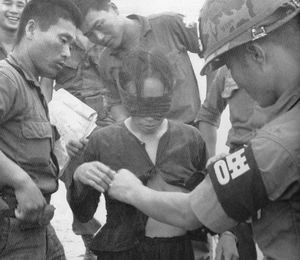
▲ South Korean soldiers with a Vietnamese woman during the Vietnamese war.
The South Korean government has yet to formally acknowledge the sexual violence that took place during the war.
A proper apology, and compensation for, the atrocities South Korean soldiers committed in Vietnam has never been given. Approximately 9,000 people were massacred and many (including children aged 12-14) raped in around 80 separate incidents which have actually been recorded. As a result of this mass rape it is said approx 5,000 – 30,000 half-Korean children were born, known as Lai Đại Hàn in Vietnamese.
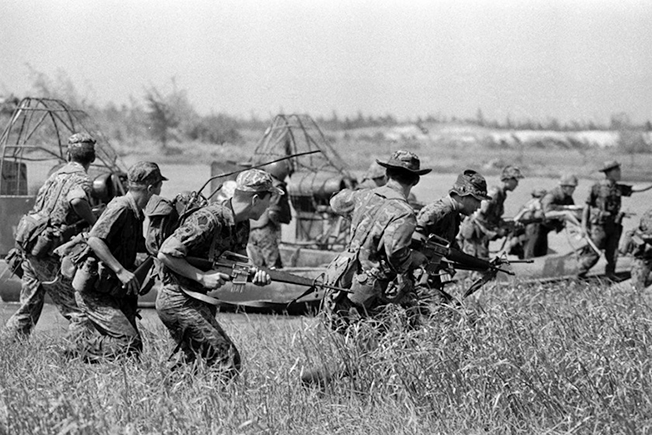
▲ South Korean soldiers in Vietnam.
BBC Report: 1968 – the year that haunts hundreds of Vietnamese women
The man had come in to buy soy sauce. Tran Thi Ngai was working as a midwife and nurse, but that morning she was looking after her parents’ shop in southern Vietnam while they were out.
He had grenades hanging from his armour, guns on his belt. It was the summer of 1967, and the Vietnam War – pitting South Vietnamese forces, the US and its allies, against the North Vietnamese Communists – was escalating.
As he approached the counter, he held out the money. As Tran reached to take it, he grabbed her arm, then her hair, and dragged her into the back room of the shop. There he raped her.
“It felt as if my life was over,” Tran says. All she could do was channel her energies into working harder than ever.
When she noticed her stomach swelling she assumed she was just putting on weight. Then one day she felt a kick and realised she was pregnant.
Her parents were horrified that she was expecting a baby out of wedlock – a major taboo. The country’s social mores were heavily influenced by Confucianism, and women were expected to remain virgins until they were married.
“My parents called me ‘chửa hoang’ (pregnant out of wedlock) – they beat me up badly.
“I didn’t want to carry on living. I felt completely dead inside.”
She tried to kill herself several times but survived – “it felt as if the foetus was fighting for me”.
Her parents only stopped beating her once she gave birth – in February 1968. She was overwhelmed by how beautiful her baby girl was, but was soon overtaken by anxiety.
“I was worried about my child growing up, worried about money, worried about how I could get back to work to earn a living.”
She named the baby Oanh. But, hard as it is to comprehend, she wanted to recognise the baby’s father in some way. The middle name would be Kim. That was the soldier’s surname. Her rapist was neither Vietnamese nor American. He was South Korean.
Four years earlier his nation had joined the US in fighting the Communist Vietcong in South Vietnam.
Not long after giving birth, Tran woke one night to find that Kim had appeared again, looking for her.
“He didn’t say a word, stood there for one or two minutes, then left,” she says.
A few days later, another South Korean soldier arrived. He had been sent by Kim to take Tran and the baby to his base – that of the 28th regiment of the South Korean White Horse Division – in a remote mountainous area south of her home town.
Ashamed and isolated, she felt she had no other choice. She got into the car and spent the next two years with her rapist. She was terrified the entire time, fearing for her life and that of the child.
“It was coercion, rape, no love was there,” she says.
Tran had another baby girl with Kim, before being abandoned when he moved to another base.
She found her way back to her parents in Phu Hiep, trying to work as many hours as possible to feed her children, until Kim once again sent a comrade to her. But this time the soldier – whose name she recalls was Park – was there, at least ostensibly, to help with the children.
“He carried them in his arms, fed them, cared for them while I was out working.”
And then one day, Park, too, assaulted her. Tran conceived another baby – a boy this time.
Her family’s social standing was now irrevocably damaged.
“It got to a point when living in the village became too difficult. Villagers shunned me, accused me of having a Korean husband, [luring the Koreans] here to kill the Vietnamese,” she says.
She and her parents fled to another part of the province, but her reputation followed her.
“If I introduced myself as ‘Ngai’, people would say ‘Oh yes, Ms Ngai. Beautiful, but she doesn’t have a husband.’”
They would ask her why she hadn’t aborted her children. She says that as a midwife she couldn’t entertain the idea.
“My job was to help other women give birth – I took care of their babies, I carried them, I embraced them, washed them, cut their cords. How could I even think of destroying my own baby?” says Tran, her voice breaking.
…
One woman who has made it her life’s mission to discover the truth is South Korean researcher Ku Su-jeong.
While doing a PhD in Vietnamese history in the 1990s, she was given a document by an official in Vietnam’s foreign ministry, describing atrocities carried out by the South Koreans.
She managed to finally secure an unauthorised copy from a Vietnamese government official for a fee, and has spent the past 20 years visiting Vietnamese villages and talking to survivors.
She believes about 9,000 South Vietnamese civilians were killed in about 80 massacres carried out by the South Koreans, although there is no way of independently verifying her research.
Ku believes there are still other deaths unaccounted for and often hears from people who want her to investigate alleged extra-judicial killings.
“I still receive calls from people who ask me to come to their village,” she says.
Her lifetime of research has come at a personal cost.
Two months after her findings were published in a South Korean newspaper article in April 1999, about 2,000 veterans in their 50s, all wearing army uniform, gathered in front of the paper’s headquarters in Seoul.
The men trashed the building and some also vandalised Ku’s home, she says. She and her mother had to move to a high security apartment.
…
“We Koreans say that we have 5,000 years of history and we’ve always been the victim. We’ve been colonised by Japan, Mongolia, China… and we endured it. It’s kind of like we’re proud of our victim mindset.”
South Korea also spent decades lobbying Japan for a similar apology over the hundreds of thousands of South Korean women forced to work as World War Two sex slaves.
Nguyen, who is deaf in one ear and seriously scarred all over her body as a result of her injuries, blames her own country for ignoring the issue. The Vietnamese government turned down two BBC requests to film for an accompanying documentary.
“Vietnam is afraid of anything that affects the relationship between the two countries so they don’t want to clarify it,” she says.
Back in Phu Hiep, Tran Thi Ngai, now 79, is also still wrestling with the fallout of the war.
She says her children have faced a lifetime of abuse and discrimination, mocked for being “lai dai han” (the Vietnamese term for the children of Vietnamese and Korean parents).
Her father was tortured and beaten to death under house arrest in 1977 as punishment for allowing his daughter to have relations with a South Korean. Tran herself was put in detention or prison three times between 1975 and 1978.
While it has not been possible to verify her specific case, the aftermath of the Vietnam War was an intense period of retribution, the country still riven with division.
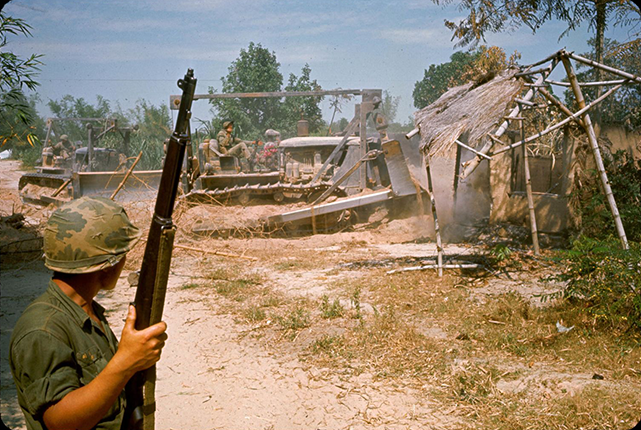
▲ South Korean soldiers bulldoze a Vietnamese village, north of Bong Sen.
Allegations of S. Korean atrocities arising 40 years after Vietnam War
Los Angeles Times May 16, 2015 6:00 am PT
By Steven Borowiec
Reporting from Seoul — Since he returned home to South Korea more than four decades ago, Kim Sung-wook’s service in the Vietnam War has been a source of pride.
The former soldier says he and the 300,000 other troops South Korea sent to the conflict sacrificed their youth and health to try to protect democracy. But, he says, that legacy is under attack.
In early April, some Vietnamese who say relatives were killed by South Korean troops visited Seoul, the capital, to speak publicly about the issue. They accused South Korean soldiers of civilian massacres along the lines of what U.S. troops did in My Lai.
The South Korean government, however, has not acknowledged that any civilian massacres took place at the hands of its troops. Kim and his comrades protested outside the Seoul venues where the Vietnamese speakers appeared.
“Our service in the war was to protect the security of Vietnam,” Kim, secretary-general of a group called Korean Victims of Agent Orange Veterans’ Assn., said in an interview. “To claim otherwise is an affront to our honor.”
Kim, who served in Vietnam from 1967 to ’69, said he knows of no South Korean soldiers who knowingly harmed civilians. He says that even though the North Vietnamese won the war, he and his fellow veterans should be remembered as heroes who fought for their country.
“We were being shot at from all directions and couldn’t always distinguish between Viet Cong and civilians when we returned fire,” the 67-year-old said.
This year is the 40th anniversary of the end of the war, which is providing an occasion for a sometimes-difficult and contentious reflection on the war despite strong economic ties between the two countries.
Seoul and Hanoi established full diplomatic relations in 1992, and bilateral trade reached $27.3 billion in 2013. The two governments last week signed a free trade agreement, which the Vietnamese government says will boost bilateral trade to $70 billion by 2020.
A large war memorial and museum in Seoul is mostly dedicated to the Korean War and has only brief mention of the Vietnam War. The capital has no memorials dedicated to the conflict in Vietnam. No major state events were planned to mark the anniversary of the war’s end. A state-sanctioned celebration for veterans was held last year — the 50th anniversary of the deployment of the first South Korean troops to Vietnam — despite a request from the Vietnamese government that it be canceled.
South Korean President Park Geun-hye visited Vietnam in 2013 and placed flowers at the mausoleum where late leader Ho Chi Minh lies in state, but made no mention of South Korea’s role in the war.
Among the reasons the Vietnam War legacy is being debated is the South Korean government’s insistence that Japan has yet to adequately apologize for its actions as colonial occupier of Korea from 1910 to ’45. The Japanese government issued official statements of guilt in 1993 and 1995 for World War II-era actions [and paid large sums in compensation in an agreement made with South Korea in 1965].
The topic of atrocities in Vietnam by South Korean soldiers was brought to broad public attention in the late 1990s in articles in left-leaning weekly newsmagazine Hankyoreh 21 by writer Koo Soo-jung, who was a graduate student in Vietnam during the war. After hearing murmurs about killings by South Korean forces, Koo researched government documents and interviewed villagers. In a series of articles, Koo told of villagers rounded up and slaughtered by South Korean troops and estimated as many as 8,000 civilian deaths.
Kim and others say that about 5,000 South Korean soldiers died in the Vietnam War and some returned with injuries and ailments caused by exposure to defoliants such as Agent Orange, which were employed by U.S. forces to kill the dense jungle that provided cover to the Viet Cong. Kim says that in combat he suffered only minor injuries, but since returning has battled mood swings and depression.
He says he understands why South Korea, a U.S. ally, joined the fight in Vietnam. South Korea’s president at the time, military dictator Park Chung-hee, argued that South Korea owed it to the U.S. to assist in the fight against communism in Vietnam to repay Americans for coming to South Korea’s aid in the 1950-53 Korean War.
Along with Park’s claims of wanting to be a good ally, scholars have pointed out that South Korean officials also saw the conflict in Vietnam as a pretext for developing South Korea’s military and economy. South Korea’s large commitment of troops led to billions of dollars in grants, loans and subsidies from the United States, as well as American support for Park’s authoritarian government.
“Park Chung-hee recognized that Korean participation in American military activities in Southeast Asia was the key to reversing the course of Korean weakness and setting the nation on a path of strength and assertiveness,” said Tae Yang Kwak, an assistant professor at Ramapo College in New Jersey who wrote his doctoral dissertation on South Korea’s role in the Vietnam War.
South Korean scholars say the government has kept much of the military’s records off limits and hasn’t investigated accusations of massacres by South Korean soldiers.
“There aren’t many ways to look into that ugly history,” said Choi Ho-rim, a professor at Dongguk University in Seoul and specialist on South Korea’s relations with Southeast Asia. “I think the government would prefer that Koreans have no memory of the war.”
Borowiec is a special correspondent.
https://www.latimes.com/world/asia/la-fg-korea-vietnam-20150516-story.html
South Korea’s War Crimes Still Haunt Vietnam
by William Duong September 1, 2017
https://thediplomat.com/2018/01/confronting-koreas-censored-discourse-on-comfort-women/
Confronting Korea’s Censored Discourse on Comfort Women
Controversy over the comfort women is partly rooted in a Manichean worldview dividing people into innocents and oppressors.
By Joseph Yi
January 31, 2018
On December 28, 2015, Japan and South Korea signed a landmark agreement over the former’s wartime sexual exploitation of Korean “comfort women.” Japan formally apologized and contributed 1 billion yen (about $8.3 million) to compensate the living survivors or the families of the deceased. In return, South Korea would consider the issue settled and dialogue with civic groups to remove a comfort woman statue in front of the Japanese embassy.
The agreement received low public support and fierce resistance from civic groups in South Korea. Activists installed new statutes, including outside the Japanese Consulate in Busan (in January 2017) and in San Francisco (November 2017). On January 4, 2018, recently elected South Korean President Moon Jae-in declared that the agreement “is defective as it not only goes against the principle of truth and justice, but did not reflect the view of the victims.” Although he did not technically void the agreement, Moon repeatedly called for new, more “sincere” apologies from Japan.
The continuing controversy over comfort women is partly rooted in a Manichean worldview that divides people into innocents and oppressors and that lacks awareness of legitimate, alternative viewpoints. In the past, South Koreans were taught that the North Korean regime was a puppet of the Soviet communists, and that contrary views reflected those of communists. Today, South Korean schools and especially media disseminate the activist claim that the Japanese Imperial military abducted 200,000 Korean women and girls, and that views to the contrary reflect those of Japanese right-wingers.
The Japanese government investigated during the 1990s and found no evidence that women from its former colonies (Korea, Taiwan) were forcibly recruited by the Imperial military. (It acknowledged that women from combatant countries, such as China and Indonesia, were illegally abducted by some soldiers and units.) In the award-winning books of professors Sarah Soh (San Francisco State) and Park Yu-ha (Sejong University), women initially offered various testimonies for working at comfort stations, such as supporting their families economically, escaping overbearing parents, or deception by brokers. Some women experienced abusive conditions at comfort stations, others more supportive.
The authors note the complicity of family and neighbors in mobilizing women into brothels, and argue that survivors should freely share their diverse experiences. However, activists pressure survivors to publicly conform to the dominant narrative of Japanese villains and innocent Koreans. For instance, Kim Hak-sun was the first Korean comfort woman to come out publicly and was the model for the San Francisco statue. In her original narrative (given to a representative of the activist Korean Council), Kim reported that her foster father took her and another girl to China, and that he worked as the manager of the local comfort station. In the 1993 published testimony, the Korean Council omitted any mention of her foster father managing the station. Similarly, the original testimony of Lee [Yi] Yong-su said that she and her friend together escaped from home. Later, in her activist role, Lee repeatedly declared that she was abducted by Japanese soldiers in the middle of the night.
The prevailing narrative of abductions is based on the oral testimonies of a small number of women (16 of 238 registered survivors in 1990s), associated with activist organizations (e.g., House of Sharing; Korean Council). A majority of living survivors (34 of 46) accepted the 2015 Japanese compensation, but the media only publicized the rejectionist minority (12). Moreover, the 61 women who accepted Japanese compensation two decades ago (the 1994 Asian Women’s Fund) were vilified as traitors and denied South Korean government subsidies. Park Yu-ha reports, “The late [survivor] Bae Chun-hee said she had not been taken by force, and that she wanted to forgive Japan but could not say so.”
South Korean media rarely discusses the well-documented finding that post-1945 South Korean governments also encouraged and supervised brothels for American soldiers or the allegation that South Korean troops patronized local women in Vietnam. No Korean publisher has translated Soh’s English-language book. A Seoul court partially censored Park’s Korean-language book and fined her 90 million won ($74,000) for defaming survivors; prosecutors requested a three-year prison sentence. A foreign (Korean-American) professor was sharply criticized for discussing the Soh book in his politics courses. The university investigated activist charges that he supported Japanese war crimes, and he was pressured to write a letter of apology.
The censored discourse reflects an underlying, authoritarian-nationalist perspective in which Koreans portray themselves as innocent victims and dissenting voices to the anti-Japanese narrative undermine South Korea’s moral power. An alternative, liberal-nationalist perspective would combine deep love of one’s country with thoughtful, nuanced analysis of a complex past. Censorship undermines the informed citizenry necessary for democratic politics and prudent policymaking. Critical, thoughtful public discourse that transcends simple victimhood narratives would serve both nations’ strategic interests and universal justice.
Joseph Yi is associate professor of political science at Hanyang University (Seoul).
Suicide of Moon money mule in Uruguay
Why did a Japanese UC member kill her Korean husband?
Robert Parry’s investigations into Sun Myung Moon
Sun Myung Moon – The Emperor of the Universe
Sun Myung Moon and the United Nations
FBI and other reports on Sun Myung Moon
The Fall of the House of Moon – New Republic
United States Congressional investigation of Moon’s organization
Sun Myung Moon organization activities in South America
A huge Moon Church scam in Japan is revealed
Shocking video of UC of Japan demanding money – English transcript
Top Japanese leader, Yoshikazu Soejima, interviewed
Moon extracted $500 million from Japanese female members
6,500 women missing from FFWPU mass weddings
Unification Church of Japan used members for profit, not religious purposes
How Moon bought protection in Japan
“Apology marriages” made by Japanese UC members to Korean men
The Atsuko Kumon Hong “suicide / murder” of August 2013

